Challenges Faced by United Cereal in the International Market
Question:
Analysis the company case and how the company can gain business benefits in the highly competitive market?
This paper aims at conducting a detailed analysis of the challenges facing case company United Cereal to provide solutions and conclusion using academic literature and secondary research findings. Investigation of the case study shows that lacks of strategic and non-strategic directions emerged challenges for the company. However, the company took initiatives in the past to overcome these challenges but disappointed. Therefore, every adopted strategy by the company for recovery are thoroughly explored while analysing for preparing further adequate solutions.
Getting Tired of Never-Ending Assignments?
Hire an Expert from MyAssignmenthelp and Get the Necessary Assignment Help at a Reasonable Rate.
Malfunctioning in the business are analysed using some critical management models and concepts. Justifications support the proposed solutions from the available pool of different solutions. Subsequently, the decision is made to ensure that alternative solutions become an essential element of the analysis. Also, the case is approached systematically to review the alternative solutions that are proposed to the company. Whereas, the proposed solutions are evaluated to understand there implications on the business stakeholders and a careful consideration is taken for resource availability and constraints.
Additionally, there is one section that is transferring the learning from the United Cereal case (retail) company to an Apple Inc. (information technology) company to offer the solutions and test the knowledge achieved from United Cereal.
This paper is a submission as a proposal to Lora Brill, United Cereal’s European Vice President to help her make a final decision based on organisational, as well as strategic considerations.
The overall purpose of undertaking this case study is to make a decision about the launch of ‘Healthy Berry Crunch’ product in Europe market and what shall be the organisation structure. Lora applied the tactics to defend the company from series of critical business challenges. However, study reveals that previously implemented strategies were not well executed, and it provoked further problematic situation. For Lora, the top priority was to lessen the marketing cost for which she intended to test ‘Healthy Berry Crunch’ as first Eurobrand product and market strategy. In her view, this single test will examine two newly developed policy i.e. launch ‘Healthy Berry Crunch’ as company's first Eurobrand and implement coordinated marketing strategy to save significant cost. Since, the product is weak and has certain defects and the implication of European strategy makes it by far the most difficult challenge for Lora.
Problem statement
Based on the case background, there are difficulties that the company has been facing during their presence in Europe market. In order to overcome these difficulties five problem statements have been formed and categorised under five subjects as listed below:
International Business
Extreme competition in the global market and global recession.
Strategy management
New product innovated and developed by United Cereal is not mature and absence of extensive market research.
Marketing management
Low price offering, powerful product promotions from the competitors and variance in the company product profile and marketing strategies.
Human resource management
Senior employee’s responsibility extended and overlapped with junior’s accountability and lack of resources to study the new product requirement.
Strategic Management Directions and Solutions
Organisational behaviour
Absence of horizontal communication, complex and difficult to coordinate organisation structure.
Study of case points that practically there exists fifteen business challenges that originated the downgrade of United Cereal’s business. Therefore, to develop the solutions for the above problems, five research questions are designed to target one problem in five academic subjects. This composition will help in covering all the major problems of the management field and thus providing solutions accordingly.
International Business
What are the challenges faced by United Cereal in the international market and how did it impact the overall business policy?
Strategy management
What are the strategic management directions that caused challenges to United Cereal and what are the solutions to these challenges?
Marketing management
Why is it necessary to conduct a market opportunity assessment before entering a new market and what should be the marketing strategies for United Cereal to gain competitive marketing management advantage?
Human resource management
Why it is significant for United Cereal to implement adequate human resource management policy in their organisational structure and what changes will it have from the overall organisational perspective?
Organisational behaviour
What are the ways to incorporate the horizontal communication structure and how to develop a new efficient and an effective organisational structure for United Cereal to overcome challenges?
Research aims
The aim of research is to implement the solutions for the upcoming business challenges. In addition, the significant contribution of this research is to apply the findings and to learn from the analysis conducted for the one retail industry to information technology industry. Both the aims are value add to the professional knowledge for solving more complex problems in the consultancy firm after course completion.
Research objectives
The essence of conducting the analysis of the case study is to research on the five subjects of management theories and practice. Usually, below five areas are responsible for a business failure. Therefore, the research objectives are:
International Business
To understand what are international challenges for an organisation and the solutions to those challenges.
Strategy management
To investigate the strategic challenges company faced and solution to gain value.
Marketing management
To explore the marketing strategies that can be used by company for achieving competitive advantages.
Human resource management
To conclude what are the best human resource management policies at the international level.
Organisational behaviour
To examine the proposed organisation structure challenges and the ways to improve the overall performance.
There are three key elements of interest for undertaking this research. First, the expansion of United Cereal in the international market encouraged to understand the notions of international market for a new product launch and market penetration of existing product. Second, to provide a framework for incorporating the corporate, business, organisational and marketing strategy in the company to develop a successful business model. The Last, this study contributes not only to academic knowledge but also helped in developing management and decision-making skill for handling real-life business scenarios and providing solutions to business problems.
Chapter One
Chapter one is an introductory section providing a very comprehensive overview of the entire work. It includes the case study background, and problem statement picked up from the case background with research questions and objective targeted to solve each problem given under management subjects. Research aim and objectives, significance of the study also contribute to this section.
Market Opportunity Assessment and Marketing Strategies
Chapter Two
Chapter two presents description of the case company situation with background and current condition in the market.
Chapter Three
Chapter three include problem statements and plan of analysis for each problem. Each problem is critically reviewed using models from the view of four authors. Lastly, research methodology, research philosophy, research design, sources of secondary data and ethical issues are described.
Chapter Four
Chapter four is a detailed analysis and findings (from the analysis) of each business problems using the models defined in chapter three.
Chapter Five
Chapter five is an assessment and an overview of the case study. Thus, providing solutions, recommendations and action plan for each problem. Further, study limitation and conclusion are also offered.
Chapter Six
Chapter six is the most signification section consisting of transferring of the knowledge achieved from chapter one to five from United Cereal case study to another company (Apple Inc.). It also includes analysing another company with the models not adopted previously in chapter three and four.
United Cereal Case brief
Company background
In 1910, United Cereal was established by Jed Tomas. Company began with the first product as a mix of essential healthy ingredients to break into breakfast food industry. The success of the first product had a radical change in the company’s business division. Afterwards, company adopted a diversified product profile (Figure1).

Figure 1: United Cereal business revenue breakdown
From one product and one market, company established a $9 billion business in the last 100 years. However, it was evident that the breakfast cereals contributed one-third of revenue. Hence, the company decided to launch a new breakfast product (Bartlett & Carlson 2011).
United Cereal current condition background
In 1952, company expanded in European market by acquiring established companies to gain the advantage of already put-in-place distribution lines. At the same time breakfast industry became too competitive letting company undergo low operating cost and high maintaining shelf space issue by competitor Kellogg.

Figure 2: Breakfast cereal industries competitive structure in Europe
In an extremely competitive market, more than 10% of revenue was spent on advertisement and marketing (Figure 3). And the profitability was highly dependent on operating efficiently, managing material costs and maximising retail shelf space.
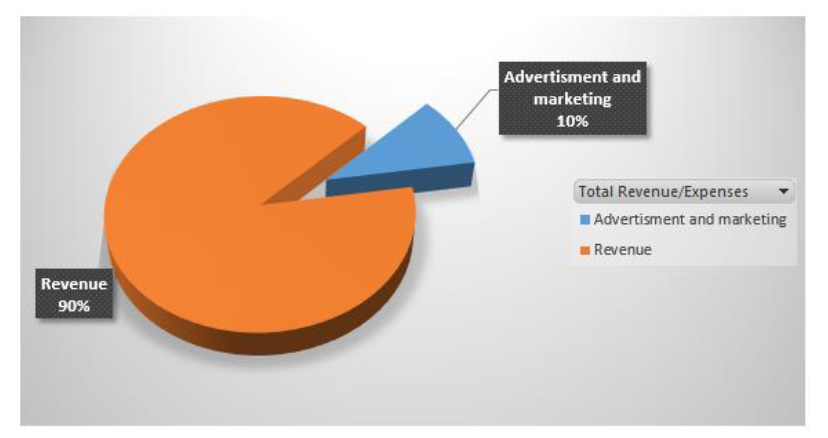
Figure 3: United Cereal revenue and expense on MAD cost
Under the company policy of “The UC way”, it conducted an extensive consumer taste-testing and implemented the feedback before the launch of new product. Company created a “mini UC” in each country it had its presence. Each “mini UC” adhere the same principles as the main branch. The organisational structure was also alike; each “mini UC” subsidiary were used for brand customization based on the local culture to maximise the profit. In 2008, the global recession changed the cereal market and the company strategy of “mini UC” created barriers when it came to horizontal communication within the company.
Human Resource Management Policies and Organizational Perspective
Moreover, company sales, general and administration expenses were too high in Europe and from 2007 to 2009; profit slowed down by 4% over worldwide (Figure 4). Return on invested capital is calculated to understand the company’s financial situation and measure the performance for previous three years.


Figure 4: United Cereal three years profit
Declining profit signals the weak performance over the financial year 2007 to 2009.
In 2002, Arne Olsen, former European VP responded to the problems and made changes to improve the horizontal communication. He formed the “European Technical Team” for leading products as he wanted to achieve economies of scale by product standardisation across Europe and expedite the R&D process. Unfortunately, he carried forward his efforts of product standardisation (for frozen fruit juice) too far that it broke the company core competencies. However, the country managers did not respond positively to his initiative as this would reduce their authority over their products; thus this experiment failed. In 2008, after global recession company faced profit and margin pressure. This economic crisis dropped the company profit and experienced a very slow market growth rate of 1% thus company focused on cutting back on costs.
Lora Brill replaced Olsen because of his flop initiative. With no surprise, Lora Brill took the charge and decided to examine how the marketing budget was being used. Study of marketing budget reflected certain major expenses that can easily be avoidable according to her.
Therefore, to save the overhead she invented “Eurobrand” strategy. Her “Eurobrand” strategy was also standardisation of product but in a different way. For her strategy was to implement at full-scale, however, the rapid decline in profits and high sales, general and administration costs caused a big problem for her and the organisation.
Problem statement and plan of analysis
Commonly, with the expansion of a company internationally, there are business problems that arise which attracts higher management attention. Therefore, it is highly significant to understand the problems to develop an in-depth analysis. This section offers fifteen major problems of the company. These problem statements are further analysed using essential management models for providing solutions. It will provide a new way of seeing critical business situation for the company management, thus result in positive change. Below mind map is used to display all the problems to get a quick overview.
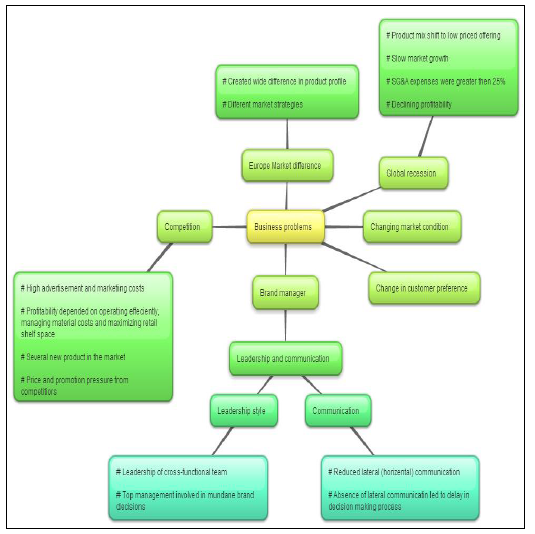
Figure 5: United Cereal's key problems
Plan of analysis
Analysis for the case study is planned systematically with the purpose to solve specific business problems arising out of a particular situation. Based on the problem and causes of such problems, relevant fifteen management models are selected to solve fifteen problems. Academically, all the business problem and challenges are mainly comprised of management subjects at certain level. Therefore, these models and challenges are classified as below in order to conduct the analysis efficiently.
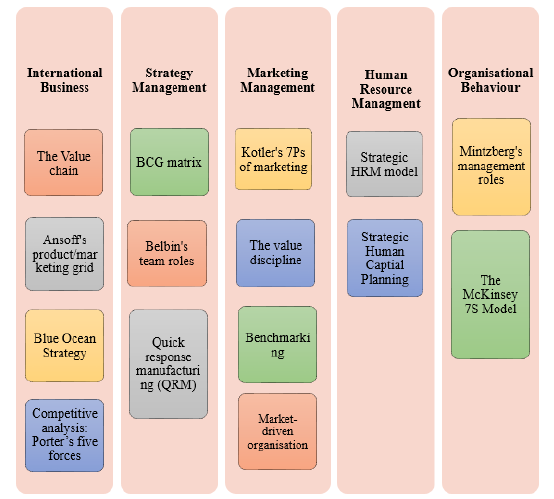
Incorporating Horizontal Communication Structure and Developing Effective Organizational Structure
Figure 6: Fifteen management models classification under five subjects
International Business Problems
1. PRESSURE ON MAINTAINING MARGIN RATHER A MARKET DEVELOPMENT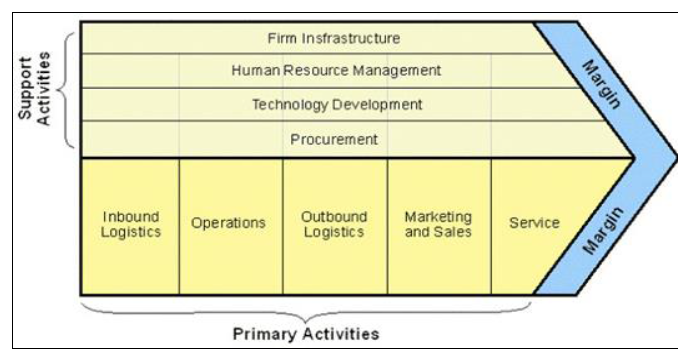
Figure 7: The Value Chain within the organisation
Source: (Porter 1985) as cited in (Johnson et al. 2008)
(Johnson et al. 2008) claims value chain is a group of activities within and around an organisation that enables the company to create a product or services. (Assen et al. 2009) argued that this model has cost efficiency as it allows the firm to gain insight into how an organisation can maximise value while keeping the minimum cost, thus create a competitive advantage. Whereas, (Hill 2009) demonstrated in his work that value chain reflects firms operations composed of diverse value creation activities. (Kaplinsky 2000) provided a very different view of the value chain that it attracts attention away from an exclusive focus on the physical transformation of the organisation to embrace the support services essential to sustain production. (Shank & Govindarajan 2004) as cited in (Dekker 2003) opinion that the chain of activities can be broken beginning from raw materials to end consumers into strategically relevant segments to gain the insight into cost behaviour and the sources of differentiation.
2. RADICAL CHANGE IN CUSTOMER PREFERENCES
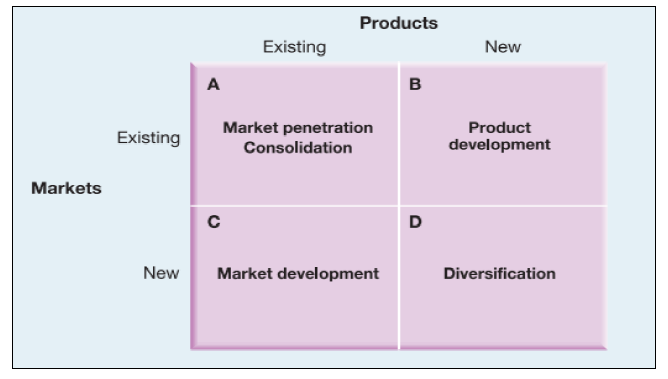
Figure 8: Strategic directions (Ansoff’s matrix)
Source: Adapted from H. Ansoff 1988 as cited in (Johnson et al. 2008)
(Ansoff 1957) claims that a firm can grow through market development, increased market penetration, product development or diversification. (Adminec 2012) justify Ansoff’s work business manager’s ability to grow their company business comes down to how they market existing and new products in existing and new markets by four distinct strategies. (Kaplan Financial 2012) argues that these strategies are identified and classified by the range of strategic options accessible to a firm and thus is exercised in the “strategic choice” element of the strategic planning process. On the contrary (Richardson & Evans 2007) points that this matrix does not uncover how to achieve these strategies and the focus is on growth, which may not be idle objective for the firm at that time.
3. GLOBAL RECESSION SLOWS DOWN THE BUSINESS

Figure 9: Blue Ocean strategy
Source: (Kim & Mauborgne 2004)
(Kim & Mauborgne 2005, 2004) evaluated that firm can implement the essential analytics from the tool to break from competition and explore the blue oceans of uncontested market space. (Yang & Yang 2011) inclined for Kim & Mauborgne statement that this strategy enables the firm for attracting non-customers and retaining existing one. The first mover approach claimed by (BUISSON & SILBERZAHN 2010) express entering first in the market and establishing a high differentiation strategy can benefit a firm to create and dominate a new area where profits flourish. (T. N. 2008) argue that “value innovation” form leaps in company and buyer’s value, releasing new demand and making competition irrelevant.
4. EXTREME COMPETITION LET OVERHEAD EXPENSES

Figure 10: The five forces framework
Source: Porter 1980
(RENKO 2011) imply that firms long-term profitability depend on the five competitive forces. Study of (Narayanan & Fahey 2005) justify (Porter 1980) strategy frame to create the warrants required to move from firm-level data to the relevant strategy conclusion. Whereas, (Slater & Olson 2002) claims that these five forces are identified in microenvironment that drive threat and competition a firm’s ability to make a profit. However, the argument is made by (Mohapatra 2012) in his studied that these forces have diverse degrees of impact in certain industries.
1. PROFITABILTY DEPEND ON NON-SALES ACTIVITIES
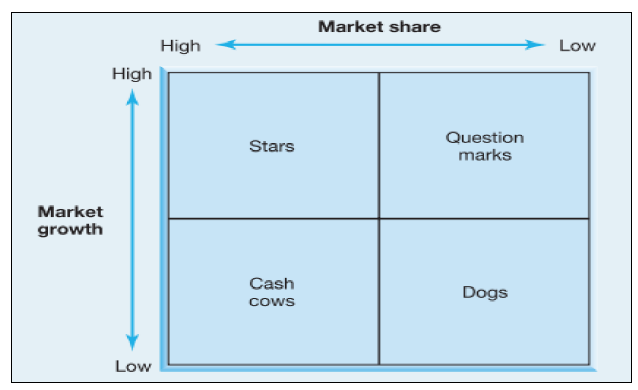
Figure 11: The growth share (or BCG matrix)
Source: (Reeves et al. 2014)
(Donald C Hambrick et al. 1982) interpreted BCG (1970), a very useful means for an organisation having relevant potential to plan the product portfolio based on the notion of the product life cycle. On the other side, BCG finds and access the priorities for growth in the product portfolio (Henderson 1969). (D. C. Hambrick et al. 1982) contradicted for having no unanimity for dividing the points on the matrix’s two dimensions. (ibid: 1973) concluded a unique principle in BCG is investment into economic growth opportunities that will in return benefit to the company.
2. EXPANSION OF THREE REGIONAL VP’S RESPONSIBILITY: A CHALLENGE TO COUNTRY MANAGER’S LOCAL AUTHORITY
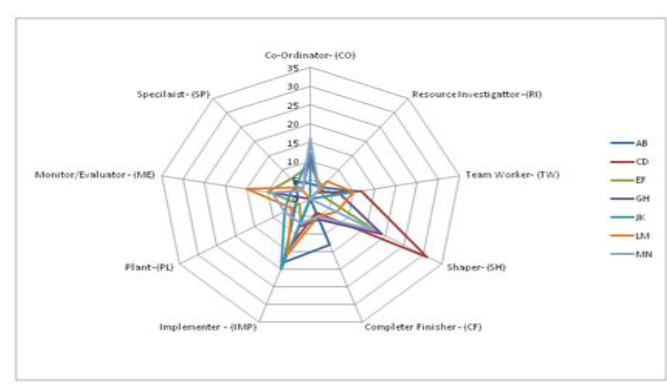
Figure 12: Belbin’s complementary roles plotted
Source: (Dr. Jungnickel & Mustafa 2012)
(Dr. Jungnickel & Mustafa 2012) clarify Belbin’s complementary roles is an operational model that help each team members to enhance self-awareness and enables them to manage their strength and weakness. (Belbin 2004) evaluated the team member’s analysis by identifying their strength and weakness in the organisation and hence using such information for building productive working relationship, build mutual trust and understanding, select and develop high-performing teams. It is not necessary to have nine team members to play strong team role (ibid: 2014) opposed previous claims. However, (Fisher 1998) argue that the degree of harmony and productiveness of a team may be predicted in terms of the task relationship paradigm using thumb rules.
3. NEW PRODUCT DEVELOPED IS NOT MATURE AND WAS TIME INTENSIVE

Figure 13: Root Cause analysis diagram
Source: (Vorley 2008)
(Rooney & Heuvel 2004) evaluated root cause analysis a method to investigate and to classify the root causes of events with reliability, quality and production impacts. However, (ASQ 2014) claims that it is one of the approaches to uncover the highest-level causes of any business problems. (Vorley 2008) and (Wilson et al. 1993) argues on Rooney & Heuvel (2004) statement that this methodology not only undertake undesired events occurring within an organisation but aim at forming corrective actions to at least alleviate, if not eliminate, the causes, thus enhance performance of the firms. Whereas, if an adequate treatment must directed at the root cause than problems and symptoms can be eliminated for once and all (Rosenfeld 2014).
1. LOW OPERATING COST BY KELLOGG AND HIGH MAINTENANCE OF SHELF SPACE ANOTHER THREAT TO UNITED CEREAL
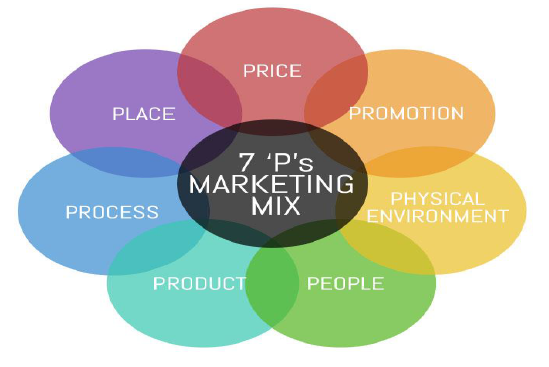
Figure 14: Marketing Mix
Source: (Kotler & Armstrong 2012a)
According to (Kotler & Dubois 1994; Kotler & Keller 2000) as cited in (Assen et al. 2009) marketing mix tool enable to position a product strategically in the marketplace. However, (Kotler & Armstrong 2012a) claims a firm can blend all its seven P’s to generate the response it wants from its target market. (Magrath 1986) inclined for Kotler & Armstrong that this is one of the framework for mixing diverse tasks as it cross-linkages evident among its mixes. Hence, it is concluded that this model has everything that a firm need to influence its product demand.
2. PRODUCT CUSTOMIZATION BASED ON A LOCAL MARKET CAUSED VARIANCE IN EXISTING PRODUCT PROFILE AND MARKET STRATEGIES

Figure 15: The Value Discipline
Source: (THE ENTERPRISE ADVOCATE 2012)
(Assen et al. 2009) research shows that no company can be everything to everyone. Company success and failure depend upon the unique value it offers to its customers by satisfying their need, and this all can be identified and discussed with the value discipline model. Whereas, (Treacy & Wiersema 1997)claims that an organisation success depends upon the competitive strategy which could are three generic value disciplines models that help a company to deliver value to its customers. The value discipline model reflect (Porter 2004) three basic strategy concepts of segmentation strategy, cost leadership and differentiation strategy. However, (THE ENTERPRISE ADVOCATE 2012) argue that there exist a difference in the value discipline and porter’s work. Value discipline focuses on customer relationship by expressing the customer intimacy value discipline whereas, Porter’s emphasis on market and Treacy & Wiersema shifted focus on customer.
3. PRODUCT CUSTOMIZATION LED SALES, GENERAL AND ADMINISTRATIVE EXPENSES; NEW PRODUCT DEVELOPMENT SLOWS DOWN AND MARKETING RESOURCES COST

Figure 16: Benchmarking
(ZiconNET 2012)
(Watson 1993) evaluate benchmarking by a systematic comparison of company processes and performances based on predefined indicators. However, (Assen et al. 2009) added to Watson research, this tool serves the objective of finding the gap between the present practices and best performance of the organisation to improve the processes or create a new standards. (Yakovleva et al. 2012) claims these best practices are used to evaluate the firm’s product, processes and services. (Bain & Company 2013) concludes the primary objective of benchmarking is to identify the examples of superior performance and to understand the practice and processes that drive the performance.
4. LACK OF RESOURCES, REDUCTION OF COST LED TO PRODUCT EXTENSIONS AND MAINTAINING PROFIT: NON-ADHERENCE OF COMPANY POLICY
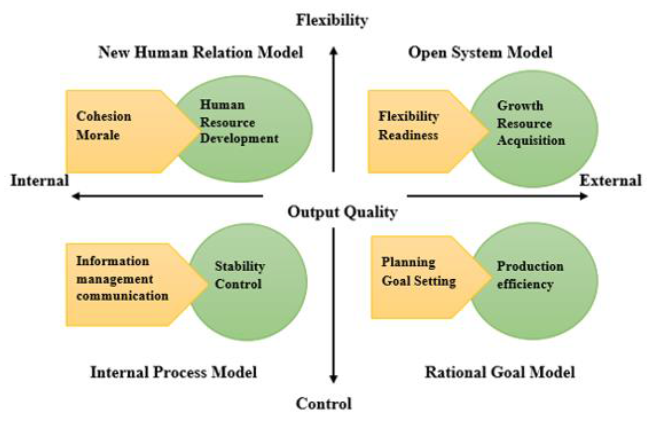
Figure 17: Competing Values Framework
(Panayotopoulou et al. 2003)
(Quinn & Rohrbaugh 1983) developed competing value to judge and understand an organisations effectiveness. (Dastmalchian et al. 2000) argues that such organisational effectiveness is subject to firm’s ability to fulfil multiple performances criteria grounded in four value sets. (Anonymous 2014) to meet the performance standards, organisations needs must be adaptable and flexible, however at the same time stable and controlled. Whereas (Paulin et al. 2000), claims that this framework addresses the organisational complexity by focusing the conflicts between change and stability and between external and internal organisation environment.
1. HUMAN RESOURCE WITH A DIVERSE BACKGROUND ALLOCATED TO LOCAL SITUATIONS
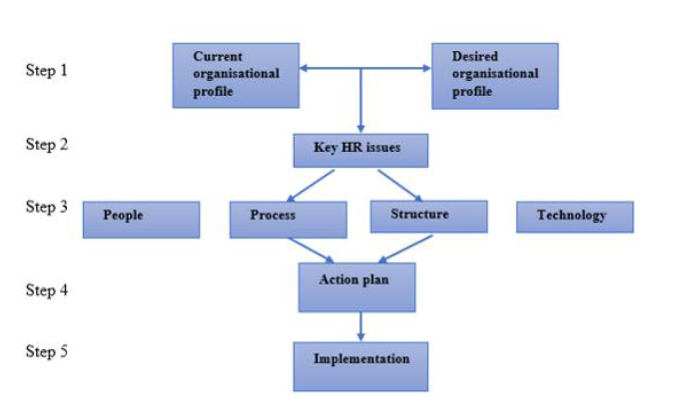
Figure 18: Strategic Human Resource Management Model
Source: (CIPD 2013)
Strategic HRM is concerned to be a human resource management approach that provide a strategic framework to support long-term goals and outcomes of business (CIPD 2013). However, (Salaman et al. 2005) claims two categories of SHRM, first is referred as identifying and pursuing to understand the organisation features that are known as factors of organisational performance. Second category of SHRM is emphasis on the ideas underpinning established practices. (Schuler 1992) argue that SHRM is an integration of HRM strategy into corporate strategies to address and solve fundamental strategic issues related to HRM in an organisation. Claims that good SHRM practices depend on internal and external firm contingencies.
2. LACK OF INSIGHT ON THE EUROPEAN MARKET DUE TO SHORTAGE OF RESOURCE, CAUSED ADVERSE CONSEQUENCES

Figure 19: Strategic Human Capital Planning
Source: (Assen et al. 2009)
(Sibson Consulting 2005) gives a practical view by implementing strategic human capital planning to enhance the company ability to identify human capital effects of corporate strategy and reform human resource services to support the business in a better way. However, (Young 2006) argue that this framework forecast and plan process that joins and directs management activities to ensure an organisation is equipped with right people at the right price to execute its business strategy. (Chatterji & Patro 2014) claim that the organisation can seize opportunities internally either by hiring individuals or retraining existing employee.
1. ABSENCE OF LATERAL COMMUNICATION
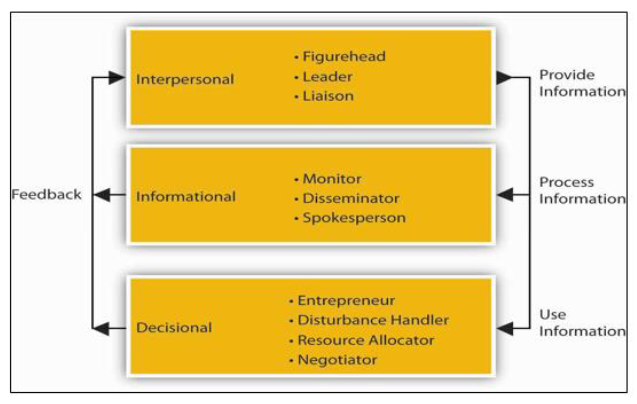
Figure 20: Mintzberg's management role
Source: (Mintzberg 1973) as cited in (Mullins 2008)
(Mintzberg 1973) interpret that each organisation should classify the manager’s activities that comprises of essential functions of top management’s job. Whereas, (Assen et al. 2009), argues that while performing a manager’s role, the ten aspects of management roles defined by Mintzberg works together as an integrated system exhibiting the manager’s competencies related to the roles. However, (Mullins 2008) claim in practical these ten roles are not easily isolated but form an integrated whole. In his viewpoint, if any of the role is removed it would have a direct effect on the manager’s efficiency and overall performance.
2. COMPLEX AND DIFFICULT TO COORDINATE ORGANISATIONAL STRUCTURE
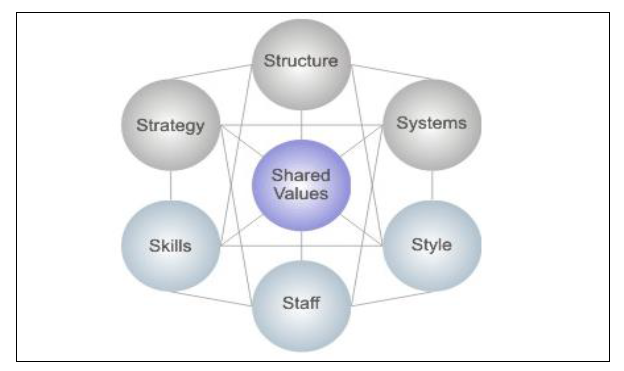
Figure 21: The McKinsey 7S Model
Source: (McKinsey 2014)
According to Thomas J. Peters and Robert H. Waterman (1980), every organisation have seven key internal aspects that need to be aligned in order to gain critical success in the business. (McKinsey 2014) argue that this framework can map the seven internal aspect that have significant influence on the organisation’s ability to change. However, (Pascale 1990) as cited in (Assen et al. 2009) argues that this model enable to analysis the present organisation and future situations thus identifying the existence of any gaps and inconsistencies between them. (Joseph et al. 2009) concluded that all these internal dynamics of an organisation determine the ability of the organisation and both the organisation structure and strategy determine management’s effectiveness.
Research methodology adopted to analyse the case study
Conducting an integrated case study analysis is the approach that allows to explore the situation within the context using a range of data sources (Jack & Baxter, 2008). However, the current research mainly depends on secondary data analysis. Therefore, this section is dedicated to the research philosophy, research design and research approaches briefly to minimise the limitations that occur when conducting research based only on secondary data.
Research philosophy
(Collis & Hussey 2009) studies show interpretivism and positivism are two primary research philosophy that enhance research approach/strategy and methods that are used to conduct research.
According to (Collins 2010) Positivism is mainly in accordance with the researcher view that information stems from human experience. Under this philosophy, every phenomenon is understood by using the scientific method that aims to form a theoretically natural language of researcher by shedding theories of subjective content. Whereas, he explain interpretivism is concerned with the philosophical position of idealism. It mainly employed to form a group of diverse approaches (such as phenomenology, social constructionism and hermeneutics) that reject the objectivist opinion that meaning is only in the world independently of consciousness.
Interpretivism approach is used in this paper. As developing the solution for the problems of an organisation moving globally, its marketing critics, human resourcing, and organisational behavioural challenges are all human construct. And the effectiveness of implementing the solutions as a tool for developing successful business model depend upon the perspective of the firm affected. The research is designed from the interpretivism viewpoint because this area of study has abundant of theories to explore and understand that how it affect the strategies of the company’s in a practical manner.
The study emphases on secondary research for accessing quick foundation of background knowledge and material for the case study. Secondary research strategy is adopted to conduct research from scholarly articles on management notions. According to (Saunders et al. 2009) secondary data is that the form of data that has been already collected, processed and stored for some purpose other than current research.
Case study is a scientific research methodology that is primary focus area of the study. A research on the case study as a research strategy aimed at undertaking an in-depth investigation of the company critics and discussing and presenting the finding with solutions.
(Colin 2002) defines a case study as “a strategy for doing research that involves an empirical investigation of a particular contemporary phenomenon within its real life context using multiple sources of evidence.”
Research are of two types qualitative and quantitative. A case study is a related technique of qualitative research; therefore, the methods adopted for writing response for this case study is qualitative. As qualitative methods, deals will the non-quantifiable elements. Whereas quantitative methods involve numbers, charts, and graphs. As the case study is a qualitative approach to solving the business problem, therefore, qualitative method fit the best. Also, this method will be sufficient to gain in-depth knowledge (Yin 2009)
Research design
The purpose of research design is to turn the research questions into the research project (Colin 2002 : 163). Therefore, research design is a general plan on how the research questions will be answered. Mainly it contains clear research objective resulting from research questions, data source to collect data and any limitation. Three major research designs are descriptive, explanatory and exploratory (ibid: 139). As the objective of undertaken case study is more than one, therefore, the current study is based on exploratory design. As an exploratory study will provide a valuable insight into the phenomena in a detail and new ways and help in understanding the problems carefully (ibid : 59) as cited in (Colin 2002)
Research approach
There are mainly two approaches to any research i.e. deductive and inductive approach. According to (Blackstone 2012 : 42) deductive research begins with social theory that the researcher find compelling and then test the implementation with data. It begins from a general level to more specific level. Also, it is associated with scientific investigation.
Figure 22: Deductive Research
Source: (Blackstone 2012)
(Saunders et al. 2009) studies show with the inductive approach there are more description opportunities of the subject matter. And the undertaken study is of an exploratory nature; collection, organising and analysis of information is directed mainly by inductive view (Robson 2002 as cited in (Saunders et al. 2009)). Therefore, based on careful understanding of both approach the current method adopted for this study is an inductive research.

Figure 23: Inductive Research
Source: (Blackstone 2012)
As the study scope is qualitative, therefore, the data, which used, is secondary. Secondary data consist of both published summaries and raw data (ibid: 256). Various method of collecting secondary data are documentary data, archives, compiled data and survey-based data (Colin 2002 : 258). These data will be useful for exploratory research and for answering research questions.
Documents and archive methods of collecting data comprise of secondary data. Additionally, archives are known as a powerful and reasonable source of data collection, and this data source is hardly used in other research approaches (Saunders et al. 2007: 378).
Written documents such as journals, books, articles, web pages and newspapers are used in writing response to case study. As these are a significant source of raw data in their way, as well as storage channel for compiled data (Colin 2002 : 258).
Ethical issues
(Appendix 1: Integrated case study ethical issues, p85)
Analysis and findings
This chapter focuses on using the models stated in chapter three for the analysis on the United Cereal and to provide a significant finding to understand the business problems.
International business
The Value chain model

 Finding
Finding
1. Massive investment in marketing and advertisement costs could have used in R&D or new product development and improving the business line in the absence or little competition.
2. Product development and marketing costs were above 23% of sales in Europe, which company could save for further business enhancement.
3. Promotions of employees at a very young age motivates them, but it brings inexperienced people move up the hierarchy, a risk for the company.

Finding
1. Company develop new product for existing market using it’s specialisation in diversified product. However, this strategic move proved to be expensive as the company had to spend significantly on developing new products.
2. With the diversification, united cereal can gain first-mover advantages by identifying new market space before their competitor assess those opportunities. This way company can offer specially designed product well ahead of its competitors.
Blue ocean strategy

Finding
1. United Cereal analysis based on blue ocean strategy shows that the company has more power and potential to fulfil the new demands of customers rather than winning the competition.
2. Analysis from red ocean strategy depicts that company fight with all its competitor to grab a greater share in the market.
3. Company established a big difference in strategic gaps compare to its competitors on the various factors valued by its customers such as reputation in innovation, understanding customer preferences, product testing and technical quality.
Porter's Five Forces Strategy
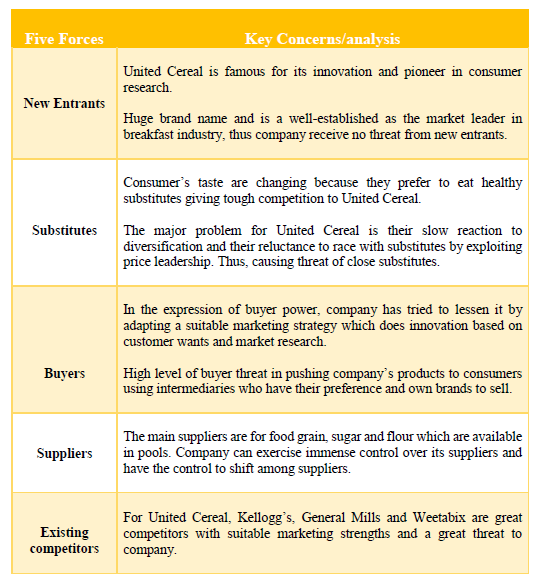
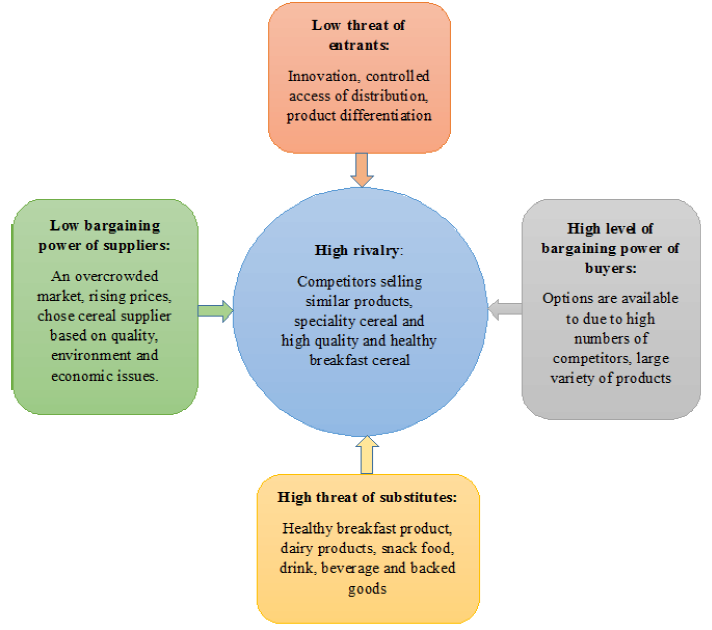
Figure 24: United Cereal Porter’s five force analysis
Findings:
1. Being the leader in breakfast cereal market, United Cereal was a brand but still affected from competitors and held second position in the market share because of lower cost strategy adopted by Kellogg.
2. Small competitors hold market position by implementing targeted price promotions and branding strategy. It is a challenge for United Cereal.
3. Company need to realise that healthy cereal breakfast and tart free products and producers are entering the market. Therefore, company need to response to these substitutes by providing a strong product in the health segment which will be difficult to imitate.
BCG matrix
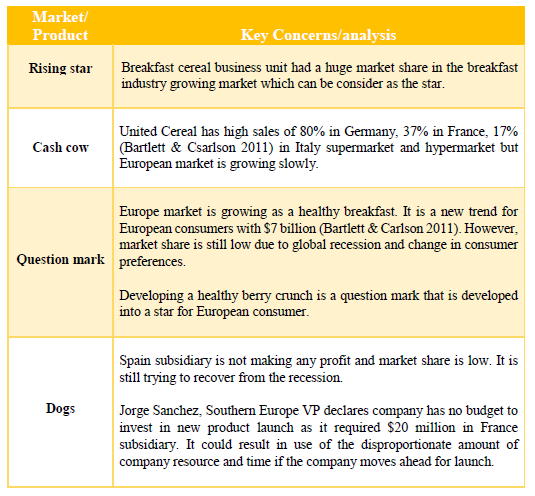 Finding
Finding
1. Healthy Crunch, a product previously launched in the health segment is low-growth product profile that is making sufficient surplus, and its fund can be an investment to higher growth or new products.
2. Company had 80% of sales in Germany which means the company need low investment, and business should be profitable. Therefore, Germany supermarket and hypermarket should be a cash cow to provide cash, helping to fund investment in healthy berry crunch known as a question mark.
Belbin's complemetary roles



Findings
1. Each country manager played the role of Plant, which shows that the company always had initial spark of ideas which the company pushes forwarded.
2. However, due to no sharper, United Cereal struggled without vision, direction, and missing deadlines.
3. Completer finisher, as the name suggests, comes in the picture at the end of a task just to polish and scrutinise the output to make it error free, to bring the highest standards of quality control. Company had to experience a major loss during standardizing juice experiment as there was no one in the company to ensure product thoroughly.
Root Cause Analysis
1. Healthy Berry crunch, new product experimented to launch in France market in the health segment was not mature. It resulted in 56% of repurchase rate (Bartlett & Carlson 2011) which does not meet the company parameter to launch a new product. The product received less favourable result because of the product weakness.
2. Product failed to meet the company’s standards of rebuying purchase rate survey i.e. 60%.
3. Though the number increased to 64% after some modification in product were made but this number is barely making the standard. High level of risk involved in introducing Healthy Berry Crunch in France. Such launch will cost company $20million (ibid: 6).
4. Country manager skipped the values of the company when it came to extensive customer research. It could turn out to be very costly.
 Figure 25: Root cause analysis of United Cereal
Figure 25: Root cause analysis of United Cereal
5. If full-scale launch of Eurobrand happens then it, will have an impact on organization structure of the company. As shown in the case study the vertical integration of the higher management in the company is impressive, due to how conventional it is and how lot of risks can be prevented. Whereas same can also be negative as Lora Brill would need to convince twelve executive for signing the document for a new launch.
6. Moving in France, could be a success because of geographic location as it has access to various water lines. Therefore, European Technical Team (ETT) would be a crucial success for Eurobrand and Healthy Berry Crunch. Expertise of ETT will make the product launched in Europe by having local differences in mind.
Marketing Management
Marketing Mix
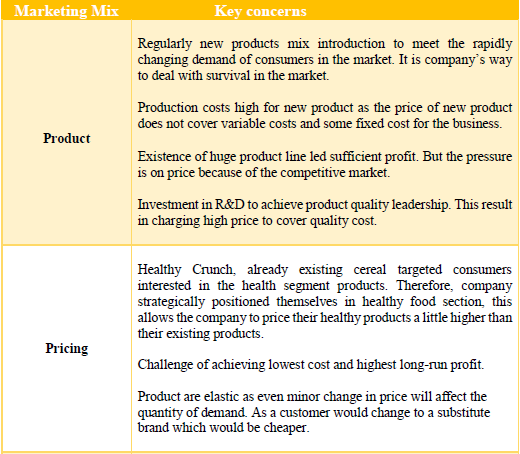


Findings
1. Internal factors such as marketing objective, strategy cost, marketing-mix, and organisation are affecting company pricing structure.
2. Company do not use their website as a distribution channel or do not sell directly to their customers. As selling online, is an emerging major source of distribution in the era of technology. Also, big food retailers use their website to sell their product online like Tesco.
3. Having contract with the retailer is a problem sometimes as in Italy that company is not able to get the shelf - space for its new product.
The value discipline

Findings
1. Challenge themselves to be a product leader in three ways: being creative, commercializing their ideas quickly and pursue new solutions to the problems that their recent product solved.
2. Company is weak in operational excellence as it do not use a strategic approach to the production of the product. Therefore, company is not able to lead its industry in price. Similarly, company face overhead costs.
The benchmarking

Findings
1. Company relied only on a small sample for testing (market) that is against company’s policy.
2. High budget requires for new product development and launch for wider market has slow down the pace of new product introduction.
3. Change in consumer preferences impacted product profile of company and let produce a new product which is an extension of Healthy Crunch, existing product in the health segment, but experienced no growth in recent years.
4. Moving in France is a late action as company lacks identifying new market opportunities
Competing Value

Findings
1. Company is dominated by the adhocracy culture as the capability of the organisation of being entrepreneurial, risk-oriented, innovative, and visionary and focused on the future.
2. The core values the company uses to dominate the market types are competitiveness and productivity.
3. To achieve total quality management organisation, requires to be efficient in all four quadrant however only a partial approach is tried by United Cereal.
Human Resource management analysis
strategic human resource management
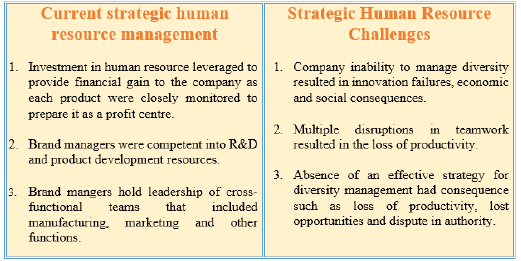
Findings
1. Company suffered from social and economic consequences because of their inability to manage diversity
2. To maintain profit, country manager were highly convinced to cut down the cost in their existing portfolios because of diverse responsibility with a diverse group of people disabled the company management to produce a quality work.
3. Lack of effective strategy management could have been recognized as a deficiency as a business problem and acknowledge the need to form and effective diversity management strategy for success.
Strategic human capital planning
1. Challenge with the strategic management of company’s workforce.
2. Promoting brand managers from within the organisation. However, it is equally important to develop and retain valuable skills, minimise risk and maximise the flexibility of its workforce which seems to be missing in the company’s organisational culture.
3. Misaligned workforce strategies with company business strategies. Each brand manager is handling cross-functional responsibility, an evident of role misalignment.
4. Lacks of strategies, concepts, measures and models to effectively manage the most significant intangible asset – employees.
Findings
1. Company had relatively independent HR based organisation that did not communicate at an enterprise level about the specific human capital requirement for their respective business units.
2. There is a decentralised HR field model where HR was not aligned according to the needs of business, and its functions were too costly at an enterprise level in comparison to value delivered.
Organisational Behaviour
Mintzberg's management role


Findings
1. At the time of reversing the declining profit company needed a leadership role which is most significant role and this would have fulfil the high level of responsibility for staffing and the motivation and guidance of subordinates.
2. Company passes external information via vertical communication. However, as per the Minztberg model, the external information is transmitted through the liaison role which is missing in organization structure.
3. Failure of juice experiment could have been eliminated with the presence of disturbance handler role. This role could have proved as a biggest defender by taking the corrective action in the involuntary situation.
4. Negotiator role is highly significant which come in picture when the company need for signing new agreement, even while documenting the copyright of product not to be intimidated by the competitors.
The Mckinesy 7s model
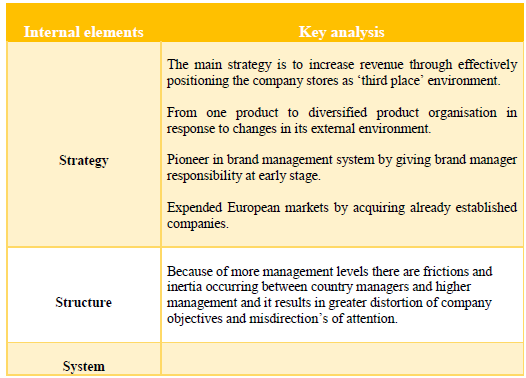
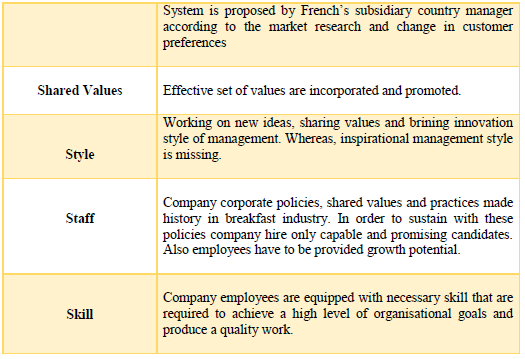
Findings
1. United Cereal management have direct influence and control over the strategy and structure of the framework.
2. However, soft element are influenced by United Cereal culture, and therefore, difficult to control.
Proposed solution, recommendation and action plan International Business
Company should refer the low-cost and product differentiation strategy to maintain the margin as well as to achieve the competitive advantage (figure 26).
1. DIFFERENTIATION STRATEGY
Use the differentiation strategy by presenting an outstanding design and more compelling breakfast products, personalised services.
2. VALUE CREATION BY FOCUS AND COST LEADERSHIP
Outsource the production to reduce operating cost to third party through vast economies of scale and focus on product development i.e. highly innovative but manufacturing can be outsourced to less developing countries where there is low cost involved.

Figure 26: Porter's model of generic strategies
Source: (Porter 2004)
Recommendation
Conduct many training programmes for employees to develop a work culture sense and handling of higher responsibility at an earlier stage that keep will staff motivated and efficient.
Highly efficient technology for cereal related processes to ensure consistency in quality and taste along with cost savings.
In the case of value, add during each step of product development, the overall value of the product increased thus enabling the company in obtaining greater profit margins.
Pick a strategic position on the efficiency frontier (a curve that shows different positions a firm can adopt to add value to the product and low cost considering the firms internal operations are configured to support a particular position) that is feasible enough that there is enough demand to support the choice.
Configure the internal operations such as marketing, manufacturing, information systems, logistics, human resources to support the position.
Right organisation structure in place is essential to execute the strategy.
Solution for problem 2
Utilise the vast amount of data about the customer preferences and competitors moves (collected through extensive market research) to draw a useful conclusion from these data.
Eliminate the distance from its final consumers by several intermediaries. Build the capability to look at the ‘true’ needs of customers and what are the factors that are ultimate drivers for product demand.
Since, company has knowledge of diversified product, it can use this skill to develop new product for existing market. However, this strategic move is expensive as significant investment is involved but profitability is also there. As penetrating their existing market will help the company to achieve higher market share.
Hold position in the breakfast market by understanding the need of the consumers.
Draw attention when entering the global market for starting up new venture in international boundaries.
Invest resources in penetrating the market as it will increase the market share of an existing product. Advertising a new product, through strategies such as branding, advertising, lower prices or volume discounts.
To execute the recommended strategies company is required to have unique toolkit of competencies that they are required to develop continuously for their customers globally.
To build the new competencies, develop a system called “Customer Excellence” – company capability to anticipate and proactively understand the customer needs.
(Appendix 2: How customer excellence will enhance the customer understanding, p85)
Solution for problem 3:
Rather than using competitors as a benchmark, look beyond the edge of existing market boundaries to gain new opportunities to form a new value for customers.
Instead of trying to beat the competition take action to develop new business offering to make the competition irrelevant and to open up and captures a new market space.
Create a new opportunity from within the existing industry by increasing the strategic boundaries of the industry.
Managers are recommended to adopt ‘blue ocean’ strategies to look up for strategic gaps, opportunities in the market that are not being completely utilised by their competitors.
Reach beyond existing demand.
Reconstruct the market boundaries.
Get the strategic sequence right by building a robust business model to ensure long-term profitability.
Overcome organisational hurdle by implementing blue ocean strategy.
Reducing management risk by motivation and competence of employees.
Amend price/performance ratio to overcome the threat of substitutes. It means keeping price in proportionate to the quality of the breakfast cereal product is what matters the most than only price.
For the company, the buyers are retailers owning supermarket and hypermarkets, not ordinary consumers. And retailers have much more negotiating power than ordinary consumers would have. Company need to overcome the pressure from retailers. Therefore, company can gain the benefits of economies of scale and can invest in costly advertisement that cannot be matched by new or potential entrants.
ACHIEVING COST EFFICIENCY
Customer can gain benefit from cost efficiency in forms of lower prices or more product feature for the same price. This strategic capability can also be a form of achieving competitive advantage. In order to attain the cost effectively, company is required to focus on below key cost drivers:

Figure 27: Sources of cost efficiency
Source: (Johnson et al. 2008)
1. ECONOMIES OF SCALE
It will enable the high cost of capital of plant to get recovered from a high degree of output. Thus reducing the price of the product for the company.
2. SUPPLY COST
Having locations near to raw material or energy sources may have influence on supply cost. As possession of raw materials could be a unique resource, giving company advantage of cost. If input cost is managed effectively it, can prove as a value add to the company success.
3. PRODUCT/PROCESS DESIGN
Improving capacity-fill, yield (from materials), labour productivity and most importantly utilisation of working capital. Company should market special offers while protecting their core business. Design of product could also have an influence on costs in another form of the value system.
4. EXPERIENCE
Undertake the activity of producing healthy berry product to build competency over time, and therefore it could do it more efficiently. As Kellogg has high market share than United Cereal, it is also understood that Kellogg has more ‘cumulative experience’ – as the high share of the market gives Kellogg greater volumes of production. Therefore, it is significant for the company to gain and hold market share.
5. A more balanced team is necessary to form to avoid disagreement among the team members.
(Appendix 4: How to create balanced team for United Cereal, p85)
1. A clear role and responsibilities for team is required to perform at its best and to realise the company potential. It is necessary for each role to achieve the team’s goal by performing adequately and efficiently.
Recommendation
1. Create team balance before a project begins so that synchronisation for weakness and potential strengths can be activated within the team.
2. Analysing team, proper guidance to manage its weaknesses and develop the team strengths.
3. For a team having members performing the same job, very few team roles prevail. Therefore, it is critical to analyse the missing key approach and outlooks such as team weakness exist in team members and identify potential conflict areas to make the team balanced.
Action Plan
1. Monitor the team members, to see how they contribute, behave within the team.
2. List down key strength, weakness and characteristics for each member.
3. Compare each member strength and weakness according to the team roles analysis conducted and note the role that most precisely describes the person.
4. Consider which roles are missing in the team? And which strengths lack in the overall team? Is there any predominant role share by many of team members?
5. Once the potential weakness, areas of conflict and missing strengths are identified then take action to improve and change this.
(Appendix 5: Action to improve the team, p86)
Solution for problem 3
Rather than launching a new product in France market where competition already exists, company should focus on strengthening the “Healthy Crunch”, an existing product already positioned in the health-conscious adult segment. As reorganising the existing product, market requires smart actions but not high expense. Company should make an attempt to understand why the “Healthy Crunch” not making any growth. Is it the product taste, product price a problem?
Recommendation
1. Focus on small supermarket for cereal sales to gain market share if not entered into France with Healthy Berry Crunch.
2. Pay close attention to possible mistake that Kellogg and Cereal Partners committed while branding and introducing their healthy cereals. It will reduce company sales, general and administration (SG&A) expenses, and this will eventually increase profit in a slow growing market.
3. Expertise and experience of regional vice presidents must combined with country manager’s knowledge in each subsidiaries market for launching a new product.
Action Plan
1. Identify the real reason behind the problem i.e. insufficient market research.
2. Integrate the negative points received from feedback gathered from the market test.
3. Develop a strategy for further testing with improved product.
4. If the result shows more than 65% of repurchase rate, company can go ahead for the France market for product launch while keeping the same organisational structure. Although, there is a jeopardy of failure but is affordable and safer alternative.
Marketing Management
Solution for problem 1
Company is proposed to maximise the firm value by pursuing strategies that increase enterprise profitability and its profit rate growth over the time (figure 28).

Figure 28: Determinants of Enterprise Value
Source: (Hill 2009)
1. Increase the profitability of either pursuing the strategy that lower costs or by pursuing a strategy that add value to the company products or by raising the prices.
2. Manage to increase the rate at which company’s profit grew over time by practising strategies to sell more product in existing markets or by entering new markets.
Recommendation
1. Appoint a negotiator role for negotiating the contract with the supermarket owners for getting shelf space.
2. Easy access to raw material and superior proprietary technology to reduce the costs.
3. Achieving cost minimisation in service, R&D, sales force, jobs based on limited and specialised tasks, advertising, increase of routine and repetition tasks, low-risk activity.
Action Plan
1. Investment in manufacturing, R&D, equipment, aggressive pricing and committed workforce will help the company to achieve low-cost strategy.
2. Discontinue activities and business line that do not produce cost advantage.
3. Outsource activities to other companies with a cost advantage.
Solution for problem 2
1. Concentrate on the product quality at the same time offer product differentiation and excellent customer services.
2. Focus on delivering the products to customers at competitive prices and with minimal inconvenience.
3. Create the capacity to tailor advertising and operations in a several store or single stores within a supermarket chain to map the need of customers of that particular store.
Recommendation
1. Narrow down the business focus to take a leadership position in the market rather broadening it.
2. Become a champion in one value discipline and should meet the industry standards in the other two to gain a lead in the competition that is difficult for the competitors to match.
Action Plan
Develop customer intimacy and combined it with detailed customer knowledge with operational flexibility to response quickly to ever changing need, from customising a product to fulfilling individual requests. This action of the company will emerge tremendous customer loyalty.
Solution for problem 4
1. Since, organisation dominates in adhocracy culture, so the areas of improvement are developing values in new products, cutting-edge ideas, creative solutions to the problems and growth in new markets as the dominant effectiveness criteria highly.
2. Being innovative, and new ideas will create new market, new opportunities and new customers as per operational theory. These are essential indicators for effective performance.
Recommendation
1. Follow the character of high levels of employee’s morale and satisfaction, teamwork and human resource development.
2. Apply market culture activities such as improving productivity, measuring customer preferences before and after product delivery, improving competitiveness by involving customers in planning design and creating partnerships with suppliers.
3. Whereas, clan culture should also be included as team building, empowerment, employee involvement, open communication and human resource development.
Action Plan
1. Make an effect to shift the company’s culture from a complacent hierarchy to a culture driven by premium return on products, customer focus and improved corporate competitiveness.
2. Apply a variety of hierarchy culture activities such as improving measurement, systematic problem-solving and process control to achieve highest levels of quality in the company.
Human Resource Management
Solution for problem 1
To protect or to increase the presence of diversity, company is proposed to create a Diversity Advisory Councils (DAC) groups. These self-organised groups offer support and networking opportunities mainly assisting and mentoring the activities that promote cultural awareness.
(Appendix 6: How to develop diversity in United Cereal? P86)
Set specific, measurable, realistic and achievable goals. Diversity training must be provided to develop the understanding of diversity and to access necessary skills to achieve
diversity business objectives. A second level of diversity training should also be conducted to develop employee’s knowledge and skills to contribute to business success.
Recommendation
Invest time and money to develop, implement, monitor and review a diversity strategy that will bring a positive result in business, suppliers, employees, products and customers.
Action Plan
Strategic actions required to manage the diversity for success in a four-step process:
1. Identify the economic consequences to the business
2. Forming an effective diversity management strategy
3. Implementing an action plan for change in the organisation
4. Evaluating the diversity strategy
Solution for problem 2
Develop a diverse portfolio of business focusing on product that have a functional advantage for customers and secure intellectual property protecting against competitors.
(Appendix 7: What are HR strategies to be pursued? P86)
Recommendation
1. To sustain an innovation-based business model, talented employee must be recruited. To improve the ability to forecast human capital requirement, company must implement robust human capital planning process to support the business, and this will enable the company to get and stay ahead of the talent curve.
2. Develop and document a human capital strategy. The base of such strategy should be human capital differentiation. It means segmenting the human capital and connecting the significance of roles to the business strategy.
Action Plan
1. Human resource management is required to renew focus on developing functional capability and service offerings to ensure company has right number, quality and talent needed to execute their strategy and retrieve the best and highest use of the talent portfolio.
2. Company need to revamp its business process from the area of human capital to gain competitive advantage.
3. Invest in training and development of employees. Here, engagement and retention strategies could be practised for optimum use of human capital.
Organisational Behaviour
Solution for problem 1
1. Incorporate lateral (horizontal) communication as it will eliminate the delay in decision-making processes. Lateral communication focuses on facilitating corporation than directing the work.
2. Employees should willingly expand their additional effort to reach out beyond their immediate team to others at the same level. It is likely to produce a high quality of information exchange it occurs in the same environment directly between two people.
3. Employees need to maintain unity within the same level of band and the resources at the same level. They all need to cooperate and communicate efficiently and work toward the same organisational objective. Thus, lateral communication aids in solving the problem faster (figure 29).

Figure 29: Lateral communication across managerial levels proposed for United Cereal
Recommendation
United Cereal can achieve their goals and objectives of launching healthy berry crunch in Europe market as a Eurobrand strategy only by means of co-ordinated efforts of their management. In order to carry out the activities of the organisation it is essential to give attention to the skills of management and fluent on managerial effectiveness.
Action Plan
1. Apply horizontal communication style more than vertical by coordinating tasks, working together and by resolving conflicts. It should be implemented in company meeting, formal digital communications, presentations, and informally in other casual exchanges within office.
2. Since, company operates internationally, time zone is required to manage to avoid any issues.
3. Each company member is expected to share their view/information not only with their top management but their co-workers at the same level to get their view too.
(Appendix 8: How to communicate horizontally effectively, p87)
Solution for problem 2
1. Reduce the number of management levels and develop flat management structure through de-layering.
2. Eurobrand team need not be formed as the team consist of too many resources, and it is too complicated to function and assigning roles.
3. Eliminate tension between country manager and vice president by only assigning the supervision role and voluntarily guidance.
Recommendation
1. Develop more efficient programmes and initiatives that would ensure that corporate values are appreciated by each workforce.
2. Incorporate inspirational management style as this will motivate greater number of workforce for higher performance with less financial resources.
Action Plan
1. There should be few level in the chain of command for the reason of morale and to enhance communication and decision-making.
2. Reduce the number of levels and increase the span of control
3. Maintain an appropriate balance between span of control and chain of command
The solutions offered in this paper refer from diverse domain of business affecting the various stakeholders. United Cereal brings positive changes to their stakeholders like such as:
EMPLOYEES
United Cereal employees will be benefited by training and development programme to enhance their professional skills to excel in their career. Company stimulates them with fair compensation, empowerment help them deliver better customer experience.
MANAGERS
For managers, they will have added responsibility to undertake and carry the company business successfully by implementing the changes under the guidance of owners.
OWNER
Implication for owner will be to maximize the interest of not only shareholder but stakeholder too. Hence, owner must incorporate the strategies to increase the market share for fulfilling the stakeholder interest.
Whereas some adverse changes are for stakeholder such as:
CUSTOMER
Faulty product in response to their demand faced backlash and negative sentiments. And there are higher chances of moving to substitutes if the same problem persists.
SUPPLIERS
Because of the availability of supplier in pool company has a high level of negotiation power with suppliers. Therefore, roles such as negotiator can get the contract sign and can implement their negotiating power for the benefit of the company, thus reduce the bargaining power of suppliers. Negotiator role would have more power to get more efficient replenishment when their inventory runs low and negotiate more reasonable costs.
Proposed business plan
(Appendix 9: Proposed Business plan, p88)
Resource availability and constraints
(Appendix 10: Resource availability and constraints, p89)
Limitation
(Appendix 11: Limitation, p89)
Introduction
The objective of this section is the application of the learning gained from chapter one to five to Apple Inc. (IT industry), a giant in producing consumer electronics. The selection of the company is based on a very careful study of the company background and current position in the market. However, the secondary research shows that the company is a huge hit in its stock market over the past few periods and is likely to hold the top position in the industry. However, no company is without flaws, hence based on the carried research it is concluded that Apple also have some weaknesses. Therefore, this chapter aims at outlining the key business problems of Apple Inc. and the analysis of the Apple Inc. business using certain models that are not applied earlier in chapter three and four.
One significant section is dedicated to transferring the learning gained from United Cereal case company to Apple Inc. Though, both the companies belong to a different domain of retail and technology respectively but there are significant management theories and strategies that are common and can be applied to both the industries. In the last, conclusion and recommendation, are offered to complete the report.
Company background
On 1st April 1976, Apple Company was established by co-founders Steve Wozniak and Steve Jobs in Cupertino, California. In 1976, Jobs and Wozniak introduced Apple I computer which proved to be a failure. However, in 1980, Apple II was launched and turned out to be a success in the company. Company offered its initial public offering (IPO) in 1980 (Dilger 2013). Apple Inc., an international American company, is a pioneer in consumer electronic products. Company is famous for its products: iPod, iPhone, Macintosh and iPad. Company owns 301 retail stores in 10 countries that are directly operated by Apple Inc. Company also runs a domain of software line: iOS, Mac OS X operating system, a mobile operating system and creativity software, etc. (The New York Times 2014). However, despite such diversification company there are malfunctioning in business that are formed as problem in the next section.
Business Problems of Apple Inc.
The primary focus is to review critical business issues, challenges and proposing solutions to overcome those business challenges and create successful business strategies.
Strategy Management Problem
1. A LESS THAN OPTIMAL PROCEDURE TO INTERNET SERVICESFailure of MobileMe, Apple Maps proves that Apple need not be first in the market with great services; it is required that they get the market. Unfortunately, Apple’s customers are getting more eager about the Apple Internet Services.
Merger and Acquisition problem
2. DIFFICULTIES WITH BIG ACQUISITIONS
Apple made an acquisition for The Quattro Wireless that is concluded as unsuccessful deal. IAD another big deal for Apple that was not entirely fruitful for the company.
International Business – Community Service Responsibility
3. A Bad Track Record With Social Product
From an internal skill set aspect, it’s not obvious that Apple can experience social and take advantage of its development from here, without having a lot of internal expertise who live and breathe socially.
Human Resource Management problem
4. EMPLOYEE TURNOVER: A BIGGEST PROBLEM TO APPLE INC.
Apple is among top IT Company that is acknowledged not only for their success but also for their skilled employees leaving the company. The risk is not just they are leaving the company, but they come up with interesting and profitable technology stuff that could have been a part of Apple.
Observing all the above problems this chapter aims at providing relevant solutions for solving the major business concerns and thus helping the firm for providing future strategic directions for a successful business portfolio.
1. SWOT Analysis
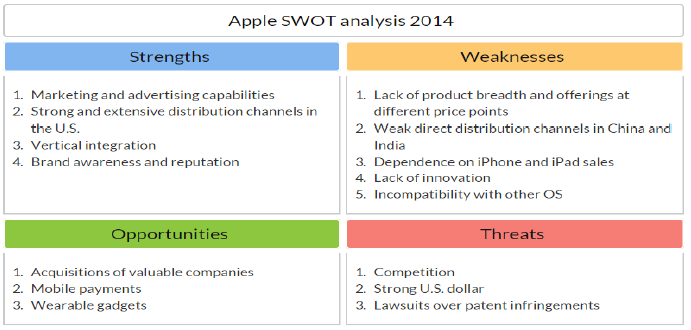
Figure 30: SWOT analysis of Apple Inc.
Strengths
1. Primary strength is consumer trustworthiness and high market position which increased because of “Apple’s ecosystem”, which helped the company to gain competitive advantage.
2. In 2013, company was awarded On-Site Generation Award and in 2012, for being the most pioneering, innovative company for 3rd time in the world (EPA 2014).
3. At the end of June 2014, Apple had $164.5 billion of cash. Company main strength lies in no debts profile and a higher rate of gross profit margin than competitors (Farrell 2014).
4. World’s most valuable brand for the second year in 2014, and its brand value is $118 billion. Apple increases its brand value by 21% on a yearly basis.
5. High quality of customer experience in Apple retail store and strong brand awareness by providing a direct speak to well-informed staff.
Weaknesses
1. High price, a significant weakness as there is robust competition in the market, and Apple customers can quickly switch to other brand providing a similar function at a lower price.
2. Declining market share could less influence its customers to use closed ecosystem of Apple.
3. Lawsuit against Apple for patent violation by its biggest competitor Samsung for disobeying its patents and company also lost some trials.
4. In 2012, company lost its founder Steve Job and after some time Tony Fadell and Scott Forstall leaders of iPod and iPhone respectively, this had an adverse impact on the management.
Opportunities
1. High demand of iPhone6 is likely to increase the Apple’s market share, and this will be again another competitive advantage.
2. With the release of iTV Apple’s TV division, sales will be increased.
3. Tablet and smartphone markets are growing rapidly; an excellent opportunity to expand company share in these markets.
4. Company is collecting damages it suffered due to violation of its patent by Samsung. Such factors play a crucial role in damaging competitor’s image in market and damage collection is another way to increase cash reserves.
5. Increased mobile advertisement acts like a lucrative opportunity as the company allows such advertisements on iPod touch, iPad and iPhone.
6. Increasing demand for cloud-based services, another opportunity for Apple to expand its iCloud and software related services (Jurevicius 2014).
Threats
1. Continuous change in technology is the biggest threat to both Apple. As customers have become used to of technology, and they expect new product in a short span of time, which caused pressure on the company.
2. Apple’s growth is likely to be affected by tax increment in USA.
3. Samsung, the only provider of application processors to Apple, had asked to pay a higher price for it. Samsung could even ask for more as currently Apple has no other application processors.
4. Android OS main competitor to Apple iOS in the mobile market. Android OS can dominate the power of Apple iOS.
5. Wide range of music stores such as Amazon, Wal-Mart and online music company such as Spotify and sound cloud are likely to be a threat for Apple music store.
2: Accretion/Dilution Analysis: A Merger Mystery
Apple is known to be the most overcapitalized company in the corporate history and company is using its money to buy back its share. Company is mainly seen as passing the cash to the shareholder in the US and doing small investment in acquisitions deals. However, Apple is making its move in M&A which does not seem to be beneficial as the company keeps away itself from significant acquisition. This problem of Apple is analysed using Accretion/Dilution analysis as below:
Accretion/Dilution answer the questions: Does the M&A deal will increase or decrease the earning per share (EPS) for Apple?
1. For every combined entity, Apple needs to estimate a pro forma net income. Estimation of net income, operational and financial synergies mainly results only once deal is finished. Like when Apple acquired Siri Inc. in 2010 is acknowledged as one of the most distinguished acquisitions of Apple.
2. The company anticipated higher revenue, due to selling of the product with the integrated features.
3. Company combined new share count increased from 1 billion to 6.58 billion after the acquisition of Siri.
4. A higher earnings per share than the original is considered as accretion for Apple during a decrease in consider as dilution. However, company made an accretion with most of its M&A.
5. Accretion analysis deal has created shareholder value, and Apple market value has been appreciated with the M&A
3. PEST analysis
PEST analysis is conducted to gain an insight of Apple Inc. business potential. It is highly required to understand the direction of operations and what is the situation of future market using PEST model.
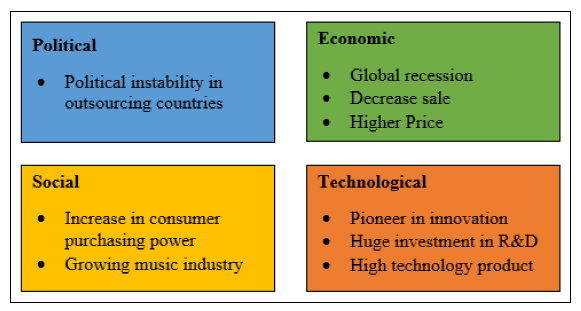
Figure 31: Apple PEST analysis
Political
Problem associated with the external environment such as geopolitical uncertainties, authority to work, war against terrorism and health matters are not in control of the company, however affect the product sales of Apple worldwide. In order to reduce operating cost Apple had outsourced in less developing countries such as China, Ireland, Korea, Cork and Czech Republic and enjoys the economies of scale. However, if any political instability occurs in such countries, it may cause a delay in Apple’s manufacturing operations. It can result in damage of brand name in the market and among consumers.
Economical
World’s economic conditions have a direct influence on buyer’s purchasing power. Because of the global recession in past few years, many countries suffered from economic crises in the form of increased unemployment. It resulted in decreased sale of Apple’s product. Inflation, another cause of economic crisis due to rising oil price, led to reduced purchasing power. It also affected the sales of Apple products because of the higher price negatively. However, improved world’s economic condition made company also in a better position. Company purchased foreign currencies, and this resulted in increased revenue of Apple in the global market (Apple Insider 2013)
Social
Apple has always focused mainly on two factors throughout the company history, the product design and quality. Because of high purchasing power the demand for luxury products has also gone high. Therefore, consumer prefers to buy iPhones, iPod, and latest technology iPad. Growing music industry has biggest social influence on Apple as the company offers essential music store such as iTunes. Therefore, Apple has benefited so much from social factors as it is defining a modern lifestyle of an individual.
Technological
Apple is a pioneer in innovation and developing high technologies product. Thus, company enjoy its technical strength as it makes a huge investment in research and development (R&D) area. These aspects make Apple a top innovator in product development.
4: The Psychological School
The psychological school is one of the models that are used to analyse the labour turnover in an organisation. It explains or predict employee’s decisions to leave the company. Therefore, it is more concerned with individual choice, and it mainly offer unitary models based on the assumption of homogeneity among employees. Hence, it is more suited to develop the policies or strategies to enable the efficient management of turnover comparison to labour, and economic market accounts (Muchinsky & Morrow 1980).
The dimension of the psychological model recognises only psychological accounts of turnover in Apple Inc. as shown below:
1. Apple’s employee decision of leaving the company include considerations of work issues.
2. Apple is more open to giving its employees more choice in assignments that just convince employee to stay in their job.
3. More experience an employee is at Apple Inc. more perks they receive another approach for employee retention.
4. Investing in employees, challenging them with excellent projects and providing a clear view of employee’s future are often the stickiness factor, and they all increase the employment.
5. Growing dissatisfaction among Apple employees and executives and more willingness to explore leaving.
6. Change in Apple culture where new leadership is on top and more pay from start-up attract Apple’s employee.
7. Apple’s competitors and other start-up are keen to hire its employees because of their talent and skill of advanced technologies.
Transfer of learning
This section is dedicated to transferring the learning and findings from the analysis conducted on the United Cereal case company to Apple Inc. case company. The knowledge is transferred between retail industries to an information technology sector. In order to understand the transfer of learning and finding a framework is developed to provide a structured outlet to the application of findings as shown on next page.

Figure 32: Transfer of leaning from United Cereal case company to Apple Inc.
Above figure is a diagrammatic view of the practical implementation of the findings between two companies irrelevant of their domain. Following are the notion acquired during writing response for United Cereal case study to solve Apple Inc. business problems:
1. TRANSFER OF UNITED CEREAL EXTEND MARKET RESEARCH AND R&D
Both the companies are extremely dedicated to high-quality services. However, United Cereal is well known for its R&D labs and extensive market research prior the launch of new breakfast products whereas this seems to be absent in Apple business in approach for new products. To illustrate the same iMap, Apple Newton, Apple eMate, U2 iPod are few Apple products that just didn’t hit the market. Although, Apple excels at thinking differently and innovation, but it need to invest in product, market research and development like United Cereal to gain a meaningful insight.
2. TRANSFER OF APPLE COST AND DIFFERENTIATION STRATEGY TO UNITED CEREAL
Although, United Cereal had pioneered in “brand management” where each brand managers were managing each brand as a profit centre. However, there is one point where Apple is doing excellent using its cost and differentiation strategy that can be applied to manage the United Cereal business in order to gain competitive advantage.
3. TRANSFER OF MERGER AND ACQUISITION STRATEGY
In the fight for share both the company, are involved in launching new products each year. Since, new product development requires time and cost therefore both moved into mergersand Acquisitions (M&A) to grow the market share. However, 20% of United Cereal’s worldwide sales were coming from M&A, which added a significant number to the company balance sheet. Whereas, for Apple, this is not the case. Apple has pile of cash which they need to invest to acquire bigger M&A like United Cereal.
4. TRANSFER OF UNITED CEREAL HR SERVICES
United Cereal founder created the company with the values of “commitment, diligence and loyalty” that mainly attracted an excellent human resource to work for the company, and they received promotion within the enterprise. However, in Apple employee turnover is experienced as the primary human resource management problem. Therefore, the skill, management of employee's with clear HR strategies applies to Apple. Such as investing in employee's training, promotions so that job satisfaction can be the factor of Apples’ employee’s stickiness to the company.
5. TRANSFER OF QUICK RESPONSE TO LOCAL MARKET
United Cereal has a strategy responding to the local market that can very well fit Apple business level strategy.
6. TRANSFER OF BALANCED TEAM
To evade from team disagreement among team members, Apple must create a balanced team. It can be achieved by mapping strength and weakness for similar team-work.
7. TRANSFER OF UNCONTESTED MARKET
United Cereal is in the form to enter into an uncontested market. Same can be applied in Apple to look, develop market where no competition exists.
8. TRANSFER OF COMPLETER FINISHER ROLE
To avoid the failure, United Cereal is recommended to assign a completer finisher role. It was seen Apple too suffered from big failure such as iMAP. However, implementing this role in the company may help Apple to escape from the major loss during the launch of iTV. As this role will enable to scrutinise the entire work to make it error free.
9. TRANSFER OF FUND FROM LOW-GROWTH PRODUCT PROFILE TO HIGHER GROWTH PRODUCT PROFILE
Like United Cereal, Apple can invest their fund gained from low-growth product that is making adequate surplus to higher growth products.
10. TRANSFER OF IDENTIFYING STRATEGIC GAP
Apple can always look for strategic gaps as opportunities that are not adequately exploited by competitors like United Cereal did.
11. TRANSFER OF LOW COST STRATEGY
United Cereal and Apple are both product leaders in their respective industries. But United Cereal adversely affected by low-cost strategy from their competitor. However, for Apple currently this is not the case. Therefore, to avoid the same in future Apple must keep low-cost strategy handy.
12. TRANSFER OF THE PRICE STRATEGY
Though United Cereal too suffered from the price war but recommendation were provided to overcome such strategic war. Therefore, same applied to Apple and company need to develop an excellent price strategy to win over the competitor.
There were certain phenomena that influenced the Apple behaviour in an interrelated complex way through United Cereal case learning. In order to optimise the transfer, significant conceptual, procedural and strategic knowledge were drawn from the United Cereal case. This learning process enables to transfer what is learned from the situation of United Cereal to Apple.
The activity of transfer of learning had a positive impact on Apple Inc. as acquisition and performance were facilitated. It was a successful application of the finding that would not only improve the Apple performance, but will also have a long lasting impact on the company.
Solution and Recommendations
For Problem 1: Extensive market research
Apple has many innovation in its name that are history in the field of technology. But it is not always essential to be the first one to enter with the new product as Apple has seen significant failure too for their products that were a huge loss to the company. Apple is currently in the plan for its innovation of internet services. However, it was once seen that Apple launched 4G while ago that turned out to be a failure. Therefore, company should be spending more time in a market research and need to be sometimes not to be first in the market. Though, it does not mean company need to be late mover but they need to be sure of their product and services before the launch.
For Problem 2: Invest in R&D and Menger and Acquisitions
Apple is sitting on an immense pile of cash on its balance sheet as company new CEO Time Cook spent $100 billion of cash on paying back the dividends and buying back its stock. In the business, the activities of spending money to buy back its share are known to be the biggest unsuitable approach one can make to utilise its money. However, company is suggested to either invest the cash into research and development (R&D) or merger and acquisition (M&A). An investment in the R&D is very critical for the Apple further growth and competition in the market. It is mainly directly related to periodically development of new products that is primarily considered as the company’s core business strategy. Therefore, company is expected to invest on R&D and M&A to remain competitive.
For Problem 3: Engage in corporate social Responsibility
Apple is known to have a poor record of building social product as company primary business is developing luxury products with high quality and design. However, there are some corporate social responsibility that major companies are currently focusing either to be ahead in the competition or for the social cause. Therefore, to save from critics Apple should consider the social aspects too.
For Problem 4: Hire right employee to avoid employee turnover
Employee turnover affect companies bottom line. It costs twice of an employee salary to find and train a replacement. And it spoils morale among remaining employees. Therefore, to lower the turnover rate at Apple it is required to have hired the right employee who not only possess skills, but also fit with the company culture and set the right compensation and perks. Offer a certain level of flexibility in choosing a project.
Conclusion and Recommendation
Through the analysis, it is concluded that Apple is appreciated for its innovation, and it is the only company that is an early adapter in the market. Company bring new innovative products to the market than competitors. Such activities are considered as most risky, but it seems to be functioning as an advantage for Apple. Company win over its competitors by acquiring strong market position and consumer loyalty because of its excellent ecosystem and user friendly products.
Being one of the most profitable company, the future of Apple is bright. However, based on the analysis company is an enormous success in the market but there are certain critics that the company face. Such as being overcapitalized is highly criticised by the investors therefore company need to pay attention to it and require to utilise the cash adequately in a profitable manner either by acquiring acquisition or by spending on R&D.
Apart from this company was seen to suffer from employee turnover issue that can be taken care by company human resource management by developing human resource strategy to retain the quality human resources. It was analysed using PEST model that the company outsource it manufacturing to different countries to reduce operating cost. It has a legal and political impact associated with the company for which company need to ensure by forming methods to save itself from both legal and political instabilities in such countries. However, there is one more point that was noticed that Samsung assist Apple for application processor for which it is likely to ask a higher amount in the future and to be a competitor it can create a problem too. Therefore, Apple is required to fine tune and improve its internal processes to overcome all such issues. The transfer of learning proved to be a successful activity where it was understood that learning is not always important what matters is the transfer of learning for the practical growth of an individual.
List of References
Adminec, 2012. Use Ansoff’s Matrix to Identify Your Growth Strategy. HJM Business Development. Available at: https://www.hjmbd.ie/use-ansoffs-matrix-to-identify-your-growth-strategy/ [Accessed January 10, 2015].
Anonymous, 2014. Competing Values Framework. Univesity of Twente. Available at: https://www.utwente.nl/cw/theorieenoverzicht/Theory clusters/Organizational Communication/Competing_Values_Framework/ [Accessed December 30, 2014].
Ansoff, H.I., 1957. Strategies for Diversification. Harvard Business Review, 35(5), pp.113–124. Available at: https://web.a.ebscohost.com/ehost/pdfviewer/pdfviewer?vid=14&sid=9775f95b-f385-4216-9450-8f4575012f64@sessionmgr4003&hid=4201 [Accessed January 10, 2015].
Apple Insider, 2013. Apple’s iPhone grew to 25.1% global market share in 2012. Apple Insider. Available at: https://appleinsider.com/articles/13/01/25/apples-iphone-grew-to-251-global-market-share-in-2012 [Accessed December 27, 2014].
ASQ, 2014. What is Root Cause Analysis (RCA)? AMERICAN SOCIETY FOR QUALITY, pp.5–13. Available at: https://asq.org/learn-about-quality/root-cause-analysis/overview/overview.html [Accessed January 7, 2015].
Assen, M. van, Berg, G. van den & Pietersma, P., 2009. Key Management Models The 60+ models every manager needs to know 2nd ed., London: Prentic Hall.
Bain & Company, 2013. Benchmarking. Bain & Company. Available at: https://www.bain.com/publications/articles/management-tools-benchmarking.aspx [Accessed January 3, 2015].
Bartlett, C.A. & Carlson, C., 2011. United Cereal: Lora Brill’s Eurobrand Challenge,
Belbin, R.M., 2004. Management Teams: Why they succeed or fail 2nd ed., Oxford: Elsevier Butterworth-Heinemann. Available at: https://books.google.co.uk/books?id=3ggtqaoxVf4C&pg=PA1&source=gbs_toc_r&cad=3#v=onepage&q&f=false.
Belbin, R.M., 2014. Team Role Theory - Belbin Team Roles. BELBIN. Available at: https://www.belbin.com/rte.asp?id=8 [Accessed December 18, 2014].
Blackstone, A., 2012. Sociological inquiry principles: Qualitative and quantitative methods, Unnamed Publisher. Available at: https://2012books.lardbucket.org/pdfs/sociological-inquiry-principles-qualitative-and-quantitative-methods.pdf.
BUISSON, B. & SILBERZAHN, P., 2010. BLUE OCEAN OR FAST-SECOND INNOVATION? A FOUR-BREAKTHROUGH MODEL TO EXPLAIN SUCCESSFUL MARKET DOMINATION. International Journal of Innovation Management, 14(03), pp.359–378. Available at:
https://www.worldscientific.com/doi/abs/10.1142/S1363919610002684 [Accessed January 2, 2015].
Chatterji, A. & Patro, A., 2014. Dynamic Capabilities and Managing Human Capital. Academy of Management Perspectives, 28(4), pp.395–408. Available at: https://amp.aom.org/cgi/doi/10.5465/amp.2013.0111 [Accessed December 22, 2014].
CIPD, 2013. Strategic human resource management. Chartered Institute of Personnel and Development. Available at: https://www.cipd.co.uk/hr-resources/factsheets/strategic-human-resource-management.aspx [Accessed December 26, 2014].
Colin, R., 2002a. Real World Research 2nd ed., John Wiley & Sons.
Colin, R., 2002b. Real World Research 2nd ed., BLACKWELL PUBLISHING. Available at: https://www.dem.fmed.uc.pt/Bibliografia/Livros_Educacao_Medica/Livro34.pdf [Accessed December 30, 2014].
Collins, H., 2010. Creative Research: The Theory and Practice of Research for the Creative Industries, AVA Publishing. Available at: https://books.google.com/books?hl=en&lr=&id=oyAwg8qSyJYC&pgis=1 [Accessed December 29, 2014].
Collis, J. & Hussey, R., 2009. Business Research - a practical guide for undergraduate & postgraduate students 3rd ed., UK: Palgrave Macmillan.
Dastmalchian, A., Lee, S. & Ng, I., 2000. The interplay between organizational and national cultures: a comparison of organizational practices in Canada and South Korea using the Competing Values Framework. International Journal of Human Resource Management, 11(2), pp.388–412. Available at: https://web.a.ebscohost.com/ehost/pdfviewer/pdfviewer?sid=9775f95b-f385-4216-9450-8f4575012f64%40sessionmgr4003&vid=85&hid=4201 [Accessed January 10, 2015].
Dekker, H.C., 2003. Value chain analysis in interfirm relationships: a field study. Management Accounting Research, 14(1), pp.1–23. Available at: https://www.sciencedirect.com/science/article/pii/S1044500502000677 [Accessed November 10, 2014].
Dilger, D.E., 2013. Apple, Inc. stock IPO created 300 millionaires 33 years ago today. Apple Insider. Available at: https://appleinsider.com/articles/13/12/12/apple-inc-stock-ipo-created-300-millionaires-33-years-ago-today [Accessed December 27, 2014].
Dr. Jungnickel, D. & Mustafa, A., 2012. Belbin and Successful Project Teams. Project SMART. Available at: https://cdn.projectsmart.co.uk/pdf/belbin-and-successful-project-teams.pdf [Accessed December 18, 2014].
EPA, U., 2014. Green Power Partnership. EPA: United State Environmental Protection Agency. Available at: https://www.epa.gov/greenpower/awards/winners.htm [Accessed December 27, 2014].
Farrell, S., 2014. Apple’s burden: a mountain of money it can't really use. theguardian. Available at: https://www.theguardian.com/technology/2014/sep/07/apple-iphone-6-cash-pile-tax-avoidance-us [Accessed December 27, 2014].
Fisher, S.G.H.T.A., 1998. The structure of Belbin’s team roles. Journal of Occupational & Organizational Psychology, 71(3), pp.283–288. Available at: https://web.a.ebscohost.com/ehost/pdfviewer/pdfviewer?sid=9775f95b-f385-4216-9450-8f4575012f64%40sessionmgr4003&vid=59&hid=4201 [Accessed January 10, 2015].
Hambrick, D.C., MacMillan, I.C. & Day, D.L., 1982. Strategic Attributes and Performance in the BCG Matrix--A PIMS-Based Analysis of Industrial Product Businesses. Academy of Management Journal, 25(3), pp.510–531. Available at: https://amj.aom.org/cgi/doi/10.2307/256077 [Accessed December 22, 2014].
Hambrick, D.C., MacMillian, I.C. & Day, D.L., 1982. Strategic Attributes and Performance in the BCG Matrix--A PIMS-Based Analysis of Industrial Product Businesses. The Academy of Management, 25(3), pp.510–531. Available at: https://www.jstor.org/discover/256077?sid=21104889903411&uid=386491061&uid=70&uid=3&uid=386491051&uid=60&uid=2&uid=3738032&uid=2134 [Accessed December 18, 2014].
Henderson, B., 1969. The Product Portfolio. BCG Perspectives, 66. Available at: https://www.bcg.de/documents/file52312.pdf.
Henderson, B.D., 1973. The experience curve reviewed: IV. The Growth Share Matrix or The Product Portfolio. BCG Perspectives, 135. Available at: https://www.bcg.com/documents/file13904.pdf.
Hill, C.W.. ., 2009. International Business Competing in the Global Marketplace 7th ed., London: Mcgraw-Hill Irwin.
Johnson, G., Scholes, K. & Whittington, R., 2008. Exploring Corporate Strategy 8th ed., London: Financial Times Prentice Hall. Available at: https://www.academia.edu/6286445/Exploring_Corporate_Strategy_Text_and_Cases_8e_by_Johnson_Scholes_Whittington.
Jurevicius, O., 2014. Apple SWOT analysis. Strategic Management Insight. Available at: https://www.strategicmanagementinsight.com/swot-analyses/apple-swot-analysis.html [Accessed December 27, 2014].
Kaplan Financial, 2012. Ansoff’s matrix. Kaplan Financial Limited. Available at: https://kfknowledgebank.kaplan.co.uk/KFKB/Wiki Pages/Ansoff’s matrix.aspx [Accessed January 10, 2015].
Kaplinsky, R., 2000. Spreading the gains from globalisation: What can be learned from value chain analysis?, Available at: https://www.globelicsacademy.org/2008/2008_lectures/Kaplinsky global value chain.pdf [Accessed January 10, 2015].
Kim, W.C. & Mauborgne, R., 2004. Blue Ocean Strategy. Harvard Business Review. Available at: https://hbr.org/2004/10/blue-ocean-strategy [Accessed December 18, 2014].
Kim, W.C. & Mauborgne, R., 2005. Blue Ocean Strategy: FROM THEORY TO PRACTICE. California Management Review, 47(3), pp.105–121. Available at: https://web.a.ebscohost.com/ehost/pdfviewer/pdfviewer?vid=24&sid=9775f95b-f385-4216-9450-8f4575012f64@sessionmgr4003&hid=4201 [Accessed January 10, 2015].
Kotler, P. & Armstrong, G., 2012a. Principles of Marketing 15th ed. S. Wall, ed., London: Pearson Education Limited.
Kotler, P. & Armstrong, G., 2012b. Principles of Marketing 15th ed., London: Pearson Education Limited. Available at: https://www.prenhall.com/behindthebook/0132390027/pdf/Kotler_CH07.pdf.
Kotler, P. & Dubois, B., 1994. Marketing Management: Analysis, planning, implementations, and control, Upper Saddle River, New Jersey: Prentic Hall.
Kotler, P. & Keller, K.., 2000. A Framework for Marketing Management 3rd ed., Upper Saddle River, New Jersey: Prentic Hall.
Magrath, A.J., 1986. When Marketing Services, 4 Ps Are Not Enough. Business Horizons, 29(3), p.44.
McKinsey, 2014. Enduring Ideas: The 7-S Framework. Insights & Publications. Available at: https://www.mckinsey.com/insights/strategy/enduring_ideas_the_7-s_framework [Accessed December 9, 2014].
Mintzberg, H., 1973. The nature of managerial work, New York: Harper and Row. Available at: https://hib510week9.pbworks.com/f/The+Nature+of+Managerial+Work,+Mintzberg+1973.pdf [Accessed November 23, 2014].
Mohapatra, S., 2012. IT and Porter’s Competitive Forces Model and Strategies. Information Systems Theory, pp.265–281.
Muchinsky, P.M. & Morrow, P.., 1980. A multidisciplinary model of voluntary employee turnover behaviour. Journal of Vocational Behaviour, 14, pp.43–77.
Mullins, L.J., 2008. Essentials of organisational behaviour 2nd ed., London: Prentic Hall.
Narayanan, V.K. & Fahey, L., 2005. The Relevance of the Institutional Underpinnings of Porter’s Five Forces Framework to Emerging Economies: An Epistemological Analysis. Journal of Management Studies, 42(1), pp.207–223. Available at: https://doi.wiley.com/10.1111/j.1467-6486.2005.00494.x [Accessed January 10, 2015].
Panayotopoulou, L., Bourantas, D. & Papalexandris, N., 2003. Strategic human resource management and its effects on firm performance: an implementation of the competing values framework. International Journal of Human Resource Management, 14(4), pp.680–699. Available at: https://web.a.ebscohost.com/ehost/pdfviewer/pdfviewer?sid=9775f95b-f385-4216-9450-8f4575012f64%40sessionmgr4003&vid=83&hid=4201 [Accessed January 10, 2015].
Paulin, M., Ferguson, R.. & Payaud, M., 2000. Effectiveness of relational and transactional cultures in commercial banking: Putting client-value into the competing values mode. International Jouranl of Bank Marketing, 18(7), pp.328–337.
Porter, M.E., 2004. competitive Advantage : Creating and sustaining superior performance, New York: Free Press; New edition edition.
Porter, M.E., 1980. Competitive Strategy: Techniques for Analyzing Industries and Competitors. New York Free Press.
Quinn, R.. & Rohrbaugh, J., 1983. A spatial model of effectiveness criteria: Towards a competing values approach to organisational analysis. Management Science, 29, pp.363–77.
RENKO, N.I.R., 2011. DESIGNING MARKETING STRATEGY USING THE FIVE COMPETITIVE FORCES MODEL BY MICHAEL E. PORTER -- CASE OF SMALL BAKERY IN CROATIA. International Journal of Management Cases, 13(3), pp.376–385. Available at: https://web.a.ebscohost.com/ehost/pdfviewer/pdfviewer?sid=9775f95b-f385-4216-9450-8f4575012f64%40sessionmgr4003&vid=51&hid=4201 [Accessed January 10, 2015].
Richardson, M. & Evans, C., 2007. Strategy in Action Applying Ansoff’s Matrix. British Journal of Administrative Management, iii(59), p.3. Available at: https://web.a.ebscohost.com/ehost/pdfviewer/pdfviewer?sid=9775f95b-f385-4216-9450-8f4575012f64@sessionmgr4003&vid=18&hid=4201 [Accessed January 10, 2015].
Rooney, J.J. & Heuvel, L.N. Vanden, 2004. Root Cause Analysis For Beginners. Quality Progress, pp.45–53. Available at: https://www.nmenv.state.nm.us/aqb/Proposed_Regs/Part_7_Excess_Emissions/NMED_Exhibit_18-Root_Cause_Analysis_for_Beginners.pdf [Accessed January 7, 2015].
Rosenfeld, Y., 2014. Root-Cause Analysis of Construction-Cost Overruns. Journal of Construction Engineering and Management, 140(1), p.04013039. Available at: https://ascelibrary.org/doi/abs/10.1061/%28ASCE%29CO.1943-7862.0000789 [Accessed January 10, 2015].
Salaman, G., Storey, J. & Billsberry, J., 2005. Strategic human resource management: defining the field 2nd ed., London: SAGE Publications Ltd. Available at: https://www.corwin.com/upm-data/9919_040313Intro.pdf.
Saunders, M., Lewish, P. & Thornhill, A., 2009. Research Method for Business Students 5th ed., London: Pearson Education Limited. Available at: https://is.vsfs.cz/el/6410/leto2014/BA_BSeBM/um/Research_Methods_for_Business_Students__5th_Edition.pdf.
Schuler, R.., 1992. Linking the People with the Strategic Needs of the Business, Organisational Dynamics.
Shank, J.. & Govindarajan, V., 2004. Strategic cost management: the value chain perspective,
Sibson Consulting, 2005. Sibson: Maximizing Value for the Business Through Strategic Human Capital Planning. PERSPECTIVES: Insights for Today’s Business Leaders, 13(2). Available at: https://www.sibson.com/publications/perspectives/Volume_13_Issue_2/e_article000388086.html [Accessed December 26, 2014].
Slater, S.F. & Olson, E.., 2002. A fresh look at industry and market analysis. Business Horizons, 45(1), pp.15–22.
T. N., S.K., 2008. Blue Ocean Strategy: How to Create Uncontested Market Space and Make the Competition Irrelevant. South Asian Journal of Management, 15(2), pp.121–124. Available at: https://web.a.ebscohost.com/ehost/pdfviewer/pdfviewer?sid=9775f95b-f385-4216-9450-8f4575012f64%40sessionmgr4003&vid=43&hid=4201 [Accessed January 10, 2015].
THE ENTERPRISE ADVOCATE, 2012. The Tracey & Wiersema Value Discipline Model. THE ENTERPRISE ADVOCATE. Available at: https://www.enterprise-advocate.com/2012/02/the-tracey-wiersema-value-discipline-model-part-1/ [Accessed January 12, 2015].
The New York Times, 2014. Apple Incorporated (AAPL) News. The New York Times. Available at: https://topics.nytimes.com/top/news/business/companies/apple_computer_inc/index.html [Accessed December 27, 2014].
Treacy, M. & Wiersema, F., 1997. The Discipline of Market Leaders: Choose Your Customers, Narrow Your Focus, Dominate Your Market, Cambridge: Basic Books. Available at: https://books.google.com/books?id=IBhIRPcAyC8C&pgis=1 [Accessed December 18, 2014].Vorley, G., 2008. Mini Guide to Root Cause Analysis, Quality Managment & Traning Ltd. Available at: https://www.root-cause-analysis.co.uk/images/Green RCA mini guide v5 small.pdf.
Watson, G.H., 1993. Strategic benchmarking: how to rate your company’s performance against the world's best illustrate., J. Wiley and Sons.
Wilson, P.F., Dell, L.D. & Anderson, G.F., 1993. Root cause analysis: A tool for total quality management, USA: ASQ Press.
Yakovleva, N., Sarkis, J. & Sloan, T., 2012. Sustainable benchmarking of supply chains: the case of the food industry. International Journal of Production Research, 50(5), pp.1297–1317. Available at: https://www.tandfonline.com/doi/abs/10.1080/00207543.2011.571926 [Accessed December 6, 2014].
Yang, C.-C. & Yang, K.-J., 2011. An integrated model of value creation based on the refined Kano’s model and the blue ocean strategy. Total Quality Management & Business Excellence, 22(9), pp.925–940. Available at: https://web.a.ebscohost.com/ehost/pdfviewer/pdfviewer?sid=9775f95b-f385-4216-9450-8f4575012f64@sessionmgr4003&vid=32&hid=4201 [Accessed January 10, 2015].
Yin, R.K., 2009. Case Study Research: Design and Methods, Available at: https://books.google.com/books?id=FzawIAdilHkC&pgis=1.
Young, M.B., 2006. Strategic Workforce Planning : Forcasting Human Captial Needs to Execute Business Strategy, Available at: https://www.conference-board.org/retrievefile.cfm?filename=Forecasting-Human-Capital-Needs-to-Execute-Business-Strategy.pdf&type=subsite.
ZiconNET, 2012. Benchmarking. ZiconNET. Available at: https://www.ziconnet.com/benchmarking.html [Accessed January 12, 2015].
(Appendix 1: Integrated case study ethical issues)
There are some ethical issues that are usually associated with research as soon the research evolves. It arises when there is an access to individuals and organisations, collect, analyse and report data. However, the subject of the work is entirely secondary data, and it is not any source to affect anyone. Entire data collected in this paper is only gathered from the secondary source of data that is publically accessible or from university credentials. The collected data is processed using certain business management models to analyse the data and write up findings, and nowhere data is stored. Therefore, research involves no privacy norms or actual participations of any organisation or individual, and there is no confidentiality of data to work on. Entire process of conducting research is in a moral and responsible way. Hence, study of United Cereal case company involves no ethical issues.
(Appendix 2: How customer excellence will enhance the customer understanding)
Customer Excellence will enable the company to assess analytically and prioritize the needs of customers. Having all the consumers’ insights about their need and desire, from the purchase in-hand, company should turn this information into customer solutions using their innovation tools. As an outcome, their innovation capability will produce a robust pipeline of breakfast products, gaining a steady-state projected value of over $4 billion (approximately).
(Appendix 3: AIDA tool for United Cereal)
AIDA tool will:
1. Begins by increasing awareness among non-existing customers of new offers for existing customers
2. Develop an interest for and a desire to have the product
3. Ensure action to buy the product.
(Appendix 4: How to create balanced team for United Cereal)
There should be a dissimilarity in the style of behaviour to ensure the balance in the team. As similar team-work strengths among team members, would be competitive (rather than co-operate) for achieving a team task and fulfilling responsibilities. Therefore, to avoid the predicted conflict between the country managers and European Vice President it is essential to manage to work together only by matching their strength and weakness.
(Appendix 5: Action to improve the team)
1. If an existing team member could compensate by firmly adopting different team role.
2. If one or more team members could enhance how they work together and with other to evade potential conflict of their natural styles.
3. Whether new skill is required to integrate to overcome team weaknesses.
(Appendix 6: How to develop diversity in United Cereal)
Steps for developing an effective strategy for managing diversity for success
1. Communicating with employees
2. Assigning responsibility
3. Allocating financial resources
4. Establishing a diversity council/task force
5. Build accountability
(Appendix 7: What are HR strategies to be pursued?)
1. Acquisition – Attract the best human talent from an external source
2. Effective resource allocation – Allocate resources effectively to maximises their use by always having the appropriate resource the appropriate place at the appropriate time.
3. Talent improvement – Maximises the existing employee’s talent by continuously training them and guiding them in their jobs and career.
4. Cost reduction – Reduce personnel costs to the lowest possible level.
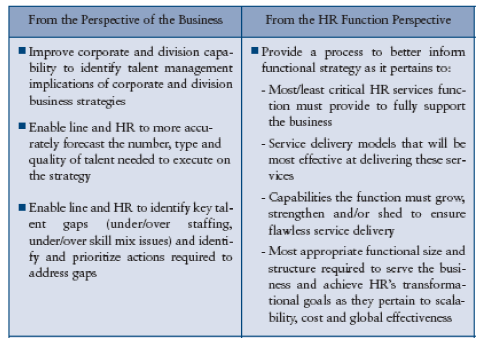
Figure 33: HC planning process and desired outcome
Steps to form a successful human capital planning process:
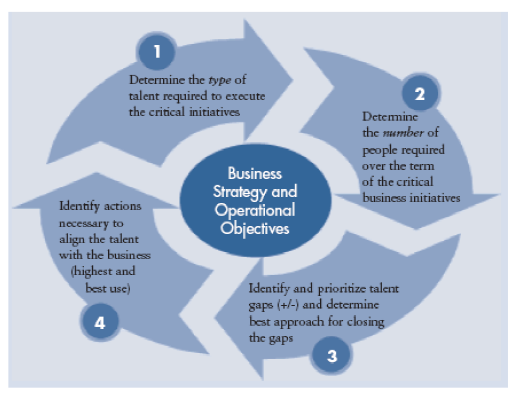
Figure 34: Human capital planning process design
(Appendix 8: How to communicate horizontally effectively)
Below essential are required to communicate horizontally effectively:
1. RECOGNITION
Implement it as realistic and useful way to exchange information.
2. EMERGENCY COMMUNICATION
It should be considered a form of emergency communication to adopt a quick resolution of a particular problem.
3. DIRECT SUPERVISION
Brand managers, country managers and vice presidents should be convinced to apply it in their respective teams.
4. DISCIPLINE
Discipline is required to maintain at each level.
5. CLEAR UNDERSTANING ABILITY
A clear understanding of horizontal communication as a function is important.
6. INTERDEPARTMENTAL COMMUNICATION INCREASE
Change is organisation structure to ensure interdepartmental communication.
7. ACT AS LUBRICANT
Department must be formed, to make horizontal communication lubricant.
(Appendix 9: Proposed Business plan)
Business plan is proposed for next three years to ensure commercial success for the United Cereal:
8. ORGANISATION STRUCTURE
United cereal is expected to not to implement any changes in the organisational structure. As some CM disagreed because of more responsibilities and lower degree of authority, and the new corporate structure might not be as efficient as planned.
9. FINANCE
United Cereal finance is getting imbalanced because of failure of huge experiments and resource mobility from one headquarter to another. This led to adverse effect on the company balance sheet. Therefore, to recover from such issues company can receive financial help to grow from bootstrapping, internal revenue service, tax increment financing, and sell stock, equipment leasing and bank. As company is already in the expansion business such sources of fund would be a great advantage for the company not only to recover but to create more strong position in the market.
1o. MARKETING MANAGEMENT
United Cereal should amend the changes in their marketing strategies and move from traditional marketing approach to a customer-driven marketing approach to building the right relationships with the right customers. Therefore, target marketing must be adopted because company can’t appeal to all buyers.
Figure.

Figure 35: Designing a customer-driven marketing strategy
Source: (Kotler & Armstrong 2012b)
(Appendix 10: Resource availability and constraints)
United Cereal is advised to build its resource capability. It is seen company has valuable brand or relevant knowledge, but there is no point if not used proficiently. Therefore, effectiveness and efficiency of financial resources, employees, equipment’s, tangible, intangible assets. Resources capacity, the relationship with supplier and consumers and the learning and experience about what works fine and what does not for the company is very essential.
(Appendix 11: Limitation)
As the study was an exploratory type of research which required ample amount of time to explore the subjects to understand the problems and to identify the right answers to those problems. Hence, time was a limited constraint. However, due to prior knowledge gained in MBA semester one and two made it little feasible to pursue the study without much difficulty and made it workable within given time frame.
To export a reference to this article please select a referencing stye below:
My Assignment Help. (2016). Solutions For Business Challenges Faced By United Cereal - Essay.. Retrieved from https://myassignmenthelp.com/free-samples/exploring-strategic-options-for-united-cereal-time-for-hard-management-decision.
"Solutions For Business Challenges Faced By United Cereal - Essay.." My Assignment Help, 2016, https://myassignmenthelp.com/free-samples/exploring-strategic-options-for-united-cereal-time-for-hard-management-decision.
My Assignment Help (2016) Solutions For Business Challenges Faced By United Cereal - Essay. [Online]. Available from: https://myassignmenthelp.com/free-samples/exploring-strategic-options-for-united-cereal-time-for-hard-management-decision
[Accessed 24 May 2025].
My Assignment Help. 'Solutions For Business Challenges Faced By United Cereal - Essay.' (My Assignment Help, 2016) <https://myassignmenthelp.com/free-samples/exploring-strategic-options-for-united-cereal-time-for-hard-management-decision> accessed 24 May 2025.
My Assignment Help. Solutions For Business Challenges Faced By United Cereal - Essay. [Internet]. My Assignment Help. 2016 [cited 24 May 2025]. Available from: https://myassignmenthelp.com/free-samples/exploring-strategic-options-for-united-cereal-time-for-hard-management-decision.
